A Diary Study of Conflict, Negative Emotions, and Performance at Work
VerifiedAdded on 2023/06/04
|18
|10898
|145
Literature Review
AI Summary
This literature review examines a diary study investigating the impact of daily workplace conflicts on employees' emotions and performance. The study, conducted in the Netherlands, explores how different types of conflict (task, relationship, and process) relate to both active (anger, contempt) and passive (sadness, guilt) negative emotions. It also introduces the concept of conflict detachment as a coping mechanism and analyzes its moderating effect on the relationship between conflict and negative emotions. The findings reveal that daily relationship and process conflicts are positively linked to negative emotions, and passive negative emotions have a lagged effect on in-role and extra-role performance. Furthermore, conflict detachment is found to mitigate the impact of conflict on negative emotions. The review highlights the study's contributions to understanding the psychological processes involved in workplace conflict and its implications for organizational practices. Desklib offers a variety of resources for students, including similar solved assignments and past papers.
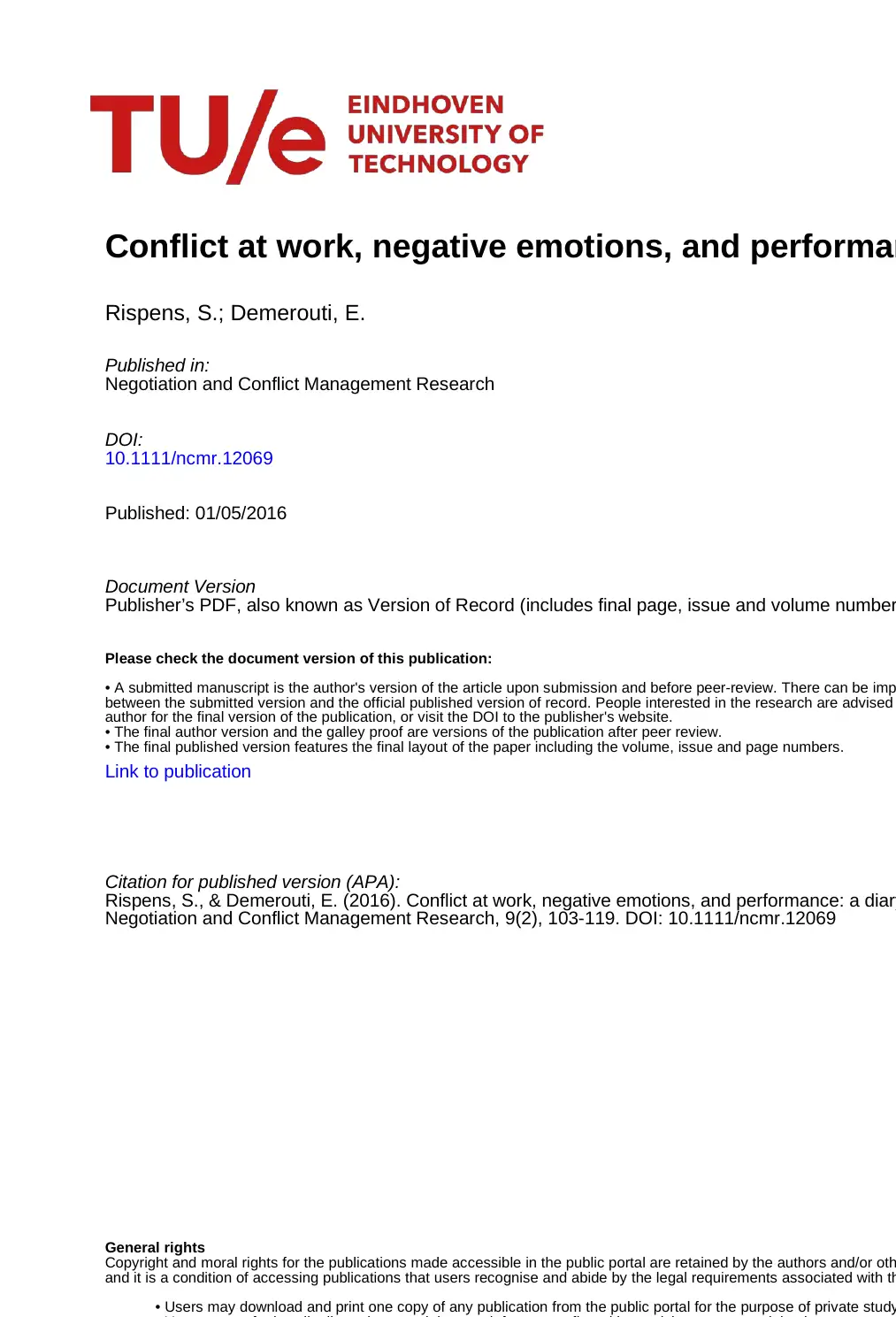
Conflict at work, negative emotions, and performan
Rispens, S.; Demerouti, E.
Published in:
Negotiation and Conflict Management Research
DOI:
10.1111/ncmr.12069
Published: 01/05/2016
Document Version
Publisher’s PDF, also known as Version of Record (includes final page, issue and volume number
Please check the document version of this publication:
• A submitted manuscript is the author's version of the article upon submission and before peer-review. There can be imp
between the submitted version and the official published version of record. People interested in the research are advised
author for the final version of the publication, or visit the DOI to the publisher's website.
• The final author version and the galley proof are versions of the publication after peer review.
• The final published version features the final layout of the paper including the volume, issue and page numbers.
Link to publication
Citation for published version (APA):
Rispens, S., & Demerouti, E. (2016). Conflict at work, negative emotions, and performance: a diar
Negotiation and Conflict Management Research, 9(2), 103-119. DOI: 10.1111/ncmr.12069
General rights
Copyright and moral rights for the publications made accessible in the public portal are retained by the authors and/or oth
and it is a condition of accessing publications that users recognise and abide by the legal requirements associated with th
• Users may download and print one copy of any publication from the public portal for the purpose of private study
Rispens, S.; Demerouti, E.
Published in:
Negotiation and Conflict Management Research
DOI:
10.1111/ncmr.12069
Published: 01/05/2016
Document Version
Publisher’s PDF, also known as Version of Record (includes final page, issue and volume number
Please check the document version of this publication:
• A submitted manuscript is the author's version of the article upon submission and before peer-review. There can be imp
between the submitted version and the official published version of record. People interested in the research are advised
author for the final version of the publication, or visit the DOI to the publisher's website.
• The final author version and the galley proof are versions of the publication after peer review.
• The final published version features the final layout of the paper including the volume, issue and page numbers.
Link to publication
Citation for published version (APA):
Rispens, S., & Demerouti, E. (2016). Conflict at work, negative emotions, and performance: a diar
Negotiation and Conflict Management Research, 9(2), 103-119. DOI: 10.1111/ncmr.12069
General rights
Copyright and moral rights for the publications made accessible in the public portal are retained by the authors and/or oth
and it is a condition of accessing publications that users recognise and abide by the legal requirements associated with th
• Users may download and print one copy of any publication from the public portal for the purpose of private study
Paraphrase This Document
Need a fresh take? Get an instant paraphrase of this document with our AI Paraphraser
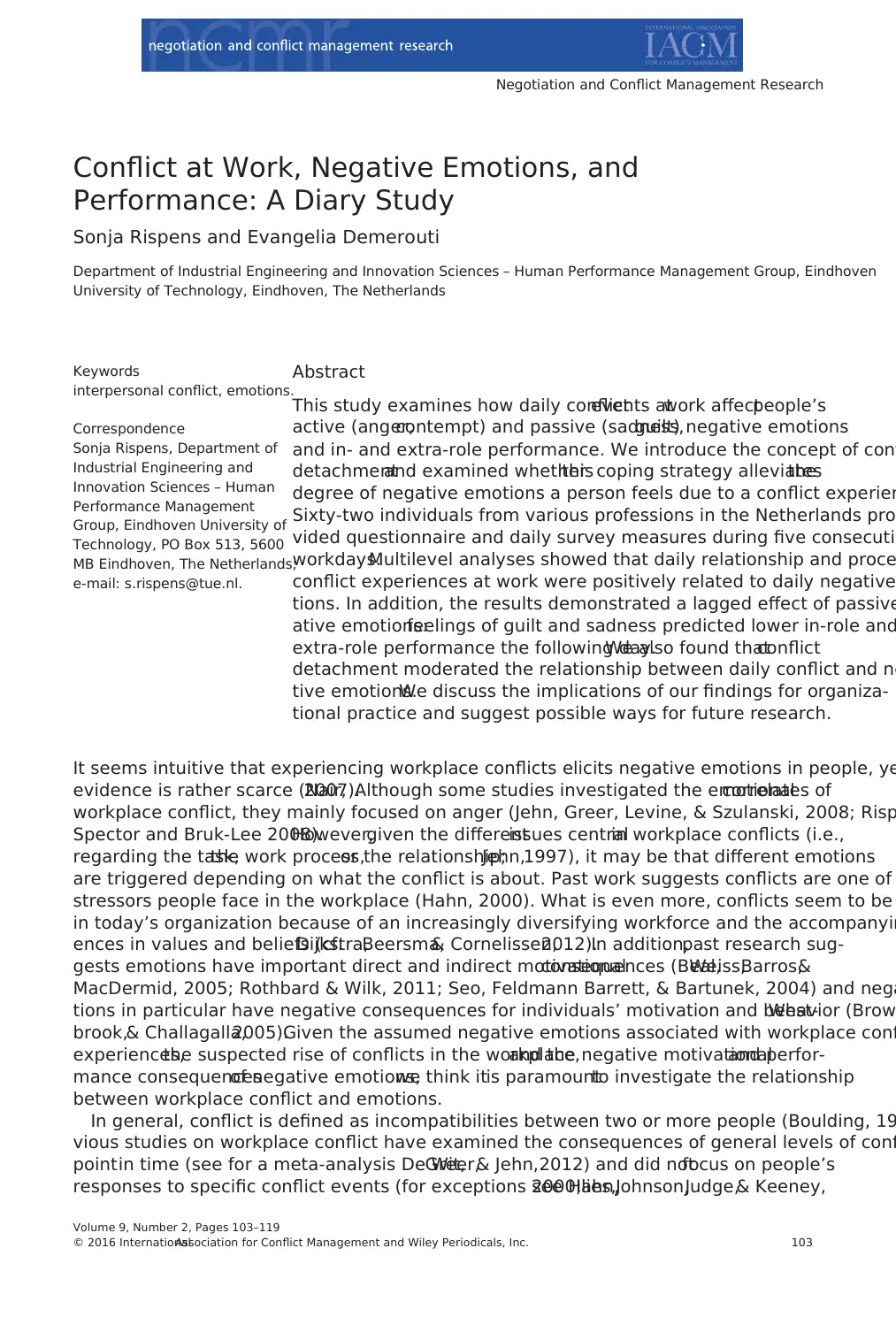
Conflict at Work, Negative Emotions, and
Performance: A Diary Study
Sonja Rispens and Evangelia Demerouti
Department of Industrial Engineering and Innovation Sciences – Human Performance Management Group, Eindhoven
University of Technology, Eindhoven, The Netherlands
Keywords
interpersonal conflict, emotions.
Correspondence
Sonja Rispens, Department of
Industrial Engineering and
Innovation Sciences – Human
Performance Management
Group, Eindhoven University of
Technology, PO Box 513, 5600
MB Eindhoven, The Netherlands;
e-mail: s.rispens@tue.nl.
Abstract
This study examines how daily conflictevents atwork affectpeople’s
active (anger,contempt) and passive (sadness,guilt) negative emotions
and in- and extra-role performance. We introduce the concept of confl
detachmentand examined whetherthis coping strategy alleviatesthe
degree of negative emotions a person feels due to a conflict experien
Sixty-two individuals from various professions in the Netherlands pro
vided questionnaire and daily survey measures during five consecutiv
workdays.Multilevel analyses showed that daily relationship and proce
conflict experiences at work were positively related to daily negative
tions. In addition, the results demonstrated a lagged effect of passive
ative emotions:feelings of guilt and sadness predicted lower in-role and
extra-role performance the following day.We also found thatconflict
detachment moderated the relationship between daily conflict and ne
tive emotions.We discuss the implications of our findings for organiza-
tional practice and suggest possible ways for future research.
It seems intuitive that experiencing workplace conflicts elicits negative emotions in people, ye
evidence is rather scarce (Nair,2007).Although some studies investigated the emotionalcorrelates of
workplace conflict, they mainly focused on anger (Jehn, Greer, Levine, & Szulanski, 2008; Risp
Spector and Bruk-Lee 2008).However,given the differentissues centralin workplace conflicts (i.e.,
regarding the task,the work process,or the relationship;Jehn,1997), it may be that different emotions
are triggered depending on what the conflict is about. Past work suggests conflicts are one of
stressors people face in the workplace (Hahn, 2000). What is even more, conflicts seem to be
in today’s organization because of an increasingly diversifying workforce and the accompanyin
ences in values and beliefs (cf.Dijkstra,Beersma,& Cornelissen,2012).In addition,past research sug-
gests emotions have important direct and indirect motivationalconsequences (Beal,Weiss,Barros,&
MacDermid, 2005; Rothbard & Wilk, 2011; Seo, Feldmann Barrett, & Bartunek, 2004) and nega
tions in particular have negative consequences for individuals’ motivation and behavior (BrowWest-
brook,& Challagalla,2005).Given the assumed negative emotions associated with workplace confl
experiences,the suspected rise of conflicts in the workplace,and the negative motivationaland perfor-
mance consequencesof negative emotions,we think itis paramountto investigate the relationship
between workplace conflict and emotions.
In general, conflict is defined as incompatibilities between two or more people (Boulding, 19
vious studies on workplace conflict have examined the consequences of general levels of confl
pointin time (see for a meta-analysis De Wit,Greer,& Jehn,2012) and did notfocus on people’s
responses to specific conflict events (for exceptions see Hahn,2000;Ilies,Johnson,Judge,& Keeney,
Negotiation and Conflict Management Research
Volume 9, Number 2, Pages 103–119
© 2016 InternationalAssociation for Conflict Management and Wiley Periodicals, Inc. 103
Performance: A Diary Study
Sonja Rispens and Evangelia Demerouti
Department of Industrial Engineering and Innovation Sciences – Human Performance Management Group, Eindhoven
University of Technology, Eindhoven, The Netherlands
Keywords
interpersonal conflict, emotions.
Correspondence
Sonja Rispens, Department of
Industrial Engineering and
Innovation Sciences – Human
Performance Management
Group, Eindhoven University of
Technology, PO Box 513, 5600
MB Eindhoven, The Netherlands;
e-mail: s.rispens@tue.nl.
Abstract
This study examines how daily conflictevents atwork affectpeople’s
active (anger,contempt) and passive (sadness,guilt) negative emotions
and in- and extra-role performance. We introduce the concept of confl
detachmentand examined whetherthis coping strategy alleviatesthe
degree of negative emotions a person feels due to a conflict experien
Sixty-two individuals from various professions in the Netherlands pro
vided questionnaire and daily survey measures during five consecutiv
workdays.Multilevel analyses showed that daily relationship and proce
conflict experiences at work were positively related to daily negative
tions. In addition, the results demonstrated a lagged effect of passive
ative emotions:feelings of guilt and sadness predicted lower in-role and
extra-role performance the following day.We also found thatconflict
detachment moderated the relationship between daily conflict and ne
tive emotions.We discuss the implications of our findings for organiza-
tional practice and suggest possible ways for future research.
It seems intuitive that experiencing workplace conflicts elicits negative emotions in people, ye
evidence is rather scarce (Nair,2007).Although some studies investigated the emotionalcorrelates of
workplace conflict, they mainly focused on anger (Jehn, Greer, Levine, & Szulanski, 2008; Risp
Spector and Bruk-Lee 2008).However,given the differentissues centralin workplace conflicts (i.e.,
regarding the task,the work process,or the relationship;Jehn,1997), it may be that different emotions
are triggered depending on what the conflict is about. Past work suggests conflicts are one of
stressors people face in the workplace (Hahn, 2000). What is even more, conflicts seem to be
in today’s organization because of an increasingly diversifying workforce and the accompanyin
ences in values and beliefs (cf.Dijkstra,Beersma,& Cornelissen,2012).In addition,past research sug-
gests emotions have important direct and indirect motivationalconsequences (Beal,Weiss,Barros,&
MacDermid, 2005; Rothbard & Wilk, 2011; Seo, Feldmann Barrett, & Bartunek, 2004) and nega
tions in particular have negative consequences for individuals’ motivation and behavior (BrowWest-
brook,& Challagalla,2005).Given the assumed negative emotions associated with workplace confl
experiences,the suspected rise of conflicts in the workplace,and the negative motivationaland perfor-
mance consequencesof negative emotions,we think itis paramountto investigate the relationship
between workplace conflict and emotions.
In general, conflict is defined as incompatibilities between two or more people (Boulding, 19
vious studies on workplace conflict have examined the consequences of general levels of confl
pointin time (see for a meta-analysis De Wit,Greer,& Jehn,2012) and did notfocus on people’s
responses to specific conflict events (for exceptions see Hahn,2000;Ilies,Johnson,Judge,& Keeney,
Negotiation and Conflict Management Research
Volume 9, Number 2, Pages 103–119
© 2016 InternationalAssociation for Conflict Management and Wiley Periodicals, Inc. 103
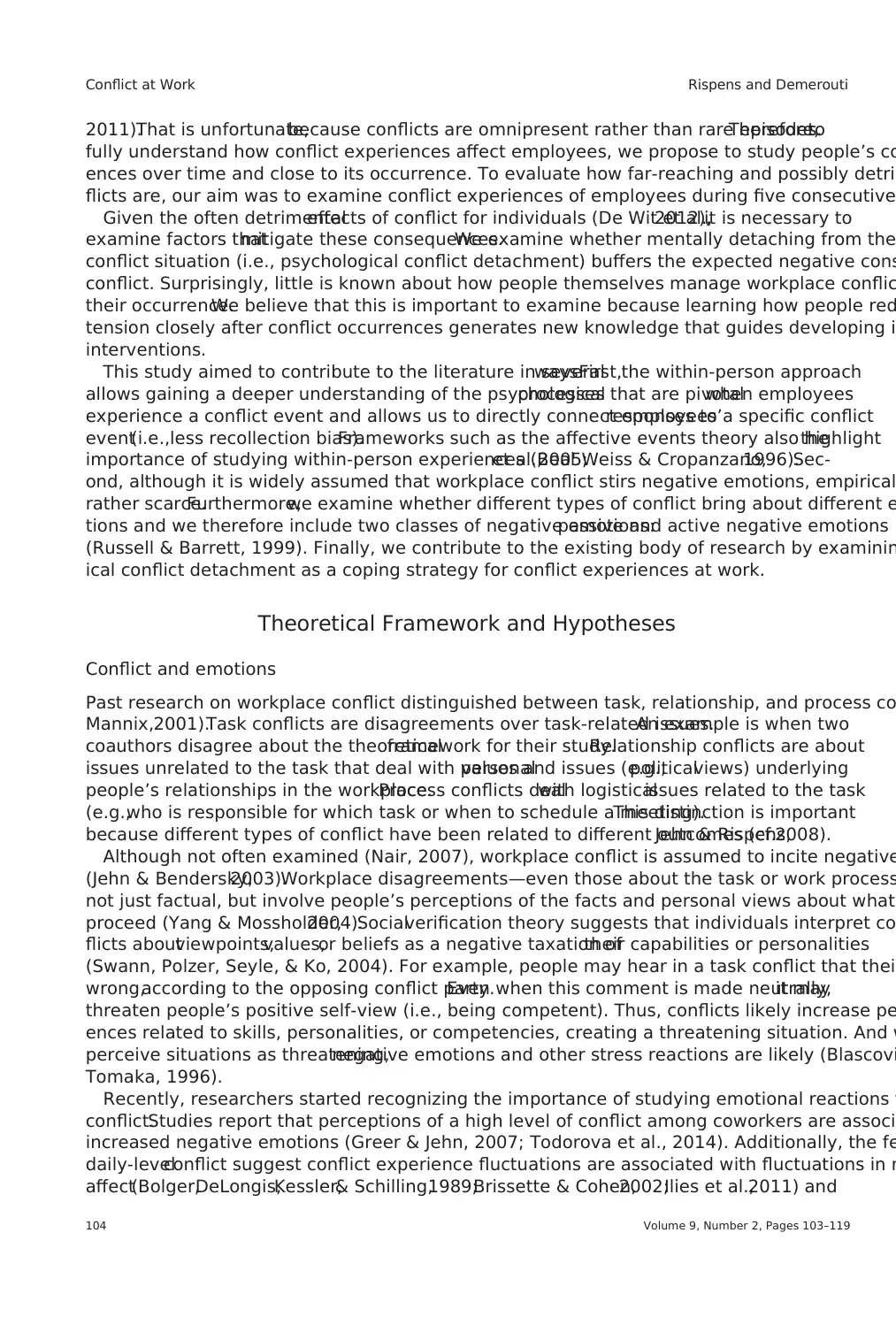
2011).That is unfortunate,because conflicts are omnipresent rather than rare episodes.Therefore,to
fully understand how conflict experiences affect employees, we propose to study people’s co
ences over time and close to its occurrence. To evaluate how far-reaching and possibly detrim
flicts are, our aim was to examine conflict experiences of employees during five consecutive
Given the often detrimentaleffects of conflict for individuals (De Wit et al.,2012),it is necessary to
examine factors thatmitigate these consequences.We examine whether mentally detaching from the
conflict situation (i.e., psychological conflict detachment) buffers the expected negative cons
conflict. Surprisingly, little is known about how people themselves manage workplace conflic
their occurrence.We believe that this is important to examine because learning how people red
tension closely after conflict occurrences generates new knowledge that guides developing i
interventions.
This study aimed to contribute to the literature in severalways.First,the within-person approach
allows gaining a deeper understanding of the psychologicalprocesses that are pivotalwhen employees
experience a conflict event and allows us to directly connect employees’responses to a specific conflict
event(i.e.,less recollection bias).Frameworks such as the affective events theory also highlightthe
importance of studying within-person experiences (Bealet al.,2005;Weiss & Cropanzano,1996).Sec-
ond, although it is widely assumed that workplace conflict stirs negative emotions, empirical
rather scarce.Furthermore,we examine whether different types of conflict bring about different e
tions and we therefore include two classes of negative emotions:passive and active negative emotions
(Russell & Barrett, 1999). Finally, we contribute to the existing body of research by examinin
ical conflict detachment as a coping strategy for conflict experiences at work.
Theoretical Framework and Hypotheses
Conflict and emotions
Past research on workplace conflict distinguished between task, relationship, and process co
Mannix,2001).Task conflicts are disagreements over task-related issues.An example is when two
coauthors disagree about the theoreticalframework for their study.Relationship conflicts are about
issues unrelated to the task that deal with personalvalues and issues (e.g.,politicalviews) underlying
people’s relationships in the workplace.Process conflicts dealwith logisticalissues related to the task
(e.g.,who is responsible for which task or when to schedule a meeting).This distinction is important
because different types of conflict have been related to different outcomes (cf.Jehn & Rispens,2008).
Although not often examined (Nair, 2007), workplace conflict is assumed to incite negative
(Jehn & Bendersky,2003).Workplace disagreements—even those about the task or work process
not just factual, but involve people’s perceptions of the facts and personal views about what
proceed (Yang & Mossholder,2004).Socialverification theory suggests that individuals interpret co
flicts aboutviewpoints,values,or beliefs as a negative taxation oftheir capabilities or personalities
(Swann, Polzer, Seyle, & Ko, 2004). For example, people may hear in a task conflict that thei
wrong,according to the opposing conflict party.Even when this comment is made neutrally,it may
threaten people’s positive self-view (i.e., being competent). Thus, conflicts likely increase pe
ences related to skills, personalities, or competencies, creating a threatening situation. And w
perceive situations as threatening,negative emotions and other stress reactions are likely (Blascovi
Tomaka, 1996).
Recently, researchers started recognizing the importance of studying emotional reactions t
conflict.Studies report that perceptions of a high level of conflict among coworkers are associ
increased negative emotions (Greer & Jehn, 2007; Todorova et al., 2014). Additionally, the fe
daily-levelconflict suggest conflict experience fluctuations are associated with fluctuations in n
affect(Bolger,DeLongis,Kessler,& Schilling,1989;Brissette & Cohen,2002;Ilies et al.,2011) and
Volume 9, Number 2, Pages 103–119104
Conflict at Work Rispens and Demerouti
fully understand how conflict experiences affect employees, we propose to study people’s co
ences over time and close to its occurrence. To evaluate how far-reaching and possibly detrim
flicts are, our aim was to examine conflict experiences of employees during five consecutive
Given the often detrimentaleffects of conflict for individuals (De Wit et al.,2012),it is necessary to
examine factors thatmitigate these consequences.We examine whether mentally detaching from the
conflict situation (i.e., psychological conflict detachment) buffers the expected negative cons
conflict. Surprisingly, little is known about how people themselves manage workplace conflic
their occurrence.We believe that this is important to examine because learning how people red
tension closely after conflict occurrences generates new knowledge that guides developing i
interventions.
This study aimed to contribute to the literature in severalways.First,the within-person approach
allows gaining a deeper understanding of the psychologicalprocesses that are pivotalwhen employees
experience a conflict event and allows us to directly connect employees’responses to a specific conflict
event(i.e.,less recollection bias).Frameworks such as the affective events theory also highlightthe
importance of studying within-person experiences (Bealet al.,2005;Weiss & Cropanzano,1996).Sec-
ond, although it is widely assumed that workplace conflict stirs negative emotions, empirical
rather scarce.Furthermore,we examine whether different types of conflict bring about different e
tions and we therefore include two classes of negative emotions:passive and active negative emotions
(Russell & Barrett, 1999). Finally, we contribute to the existing body of research by examinin
ical conflict detachment as a coping strategy for conflict experiences at work.
Theoretical Framework and Hypotheses
Conflict and emotions
Past research on workplace conflict distinguished between task, relationship, and process co
Mannix,2001).Task conflicts are disagreements over task-related issues.An example is when two
coauthors disagree about the theoreticalframework for their study.Relationship conflicts are about
issues unrelated to the task that deal with personalvalues and issues (e.g.,politicalviews) underlying
people’s relationships in the workplace.Process conflicts dealwith logisticalissues related to the task
(e.g.,who is responsible for which task or when to schedule a meeting).This distinction is important
because different types of conflict have been related to different outcomes (cf.Jehn & Rispens,2008).
Although not often examined (Nair, 2007), workplace conflict is assumed to incite negative
(Jehn & Bendersky,2003).Workplace disagreements—even those about the task or work process
not just factual, but involve people’s perceptions of the facts and personal views about what
proceed (Yang & Mossholder,2004).Socialverification theory suggests that individuals interpret co
flicts aboutviewpoints,values,or beliefs as a negative taxation oftheir capabilities or personalities
(Swann, Polzer, Seyle, & Ko, 2004). For example, people may hear in a task conflict that thei
wrong,according to the opposing conflict party.Even when this comment is made neutrally,it may
threaten people’s positive self-view (i.e., being competent). Thus, conflicts likely increase pe
ences related to skills, personalities, or competencies, creating a threatening situation. And w
perceive situations as threatening,negative emotions and other stress reactions are likely (Blascovi
Tomaka, 1996).
Recently, researchers started recognizing the importance of studying emotional reactions t
conflict.Studies report that perceptions of a high level of conflict among coworkers are associ
increased negative emotions (Greer & Jehn, 2007; Todorova et al., 2014). Additionally, the fe
daily-levelconflict suggest conflict experience fluctuations are associated with fluctuations in n
affect(Bolger,DeLongis,Kessler,& Schilling,1989;Brissette & Cohen,2002;Ilies et al.,2011) and
Volume 9, Number 2, Pages 103–119104
Conflict at Work Rispens and Demerouti
⊘ This is a preview!⊘
Do you want full access?
Subscribe today to unlock all pages.

Trusted by 1+ million students worldwide
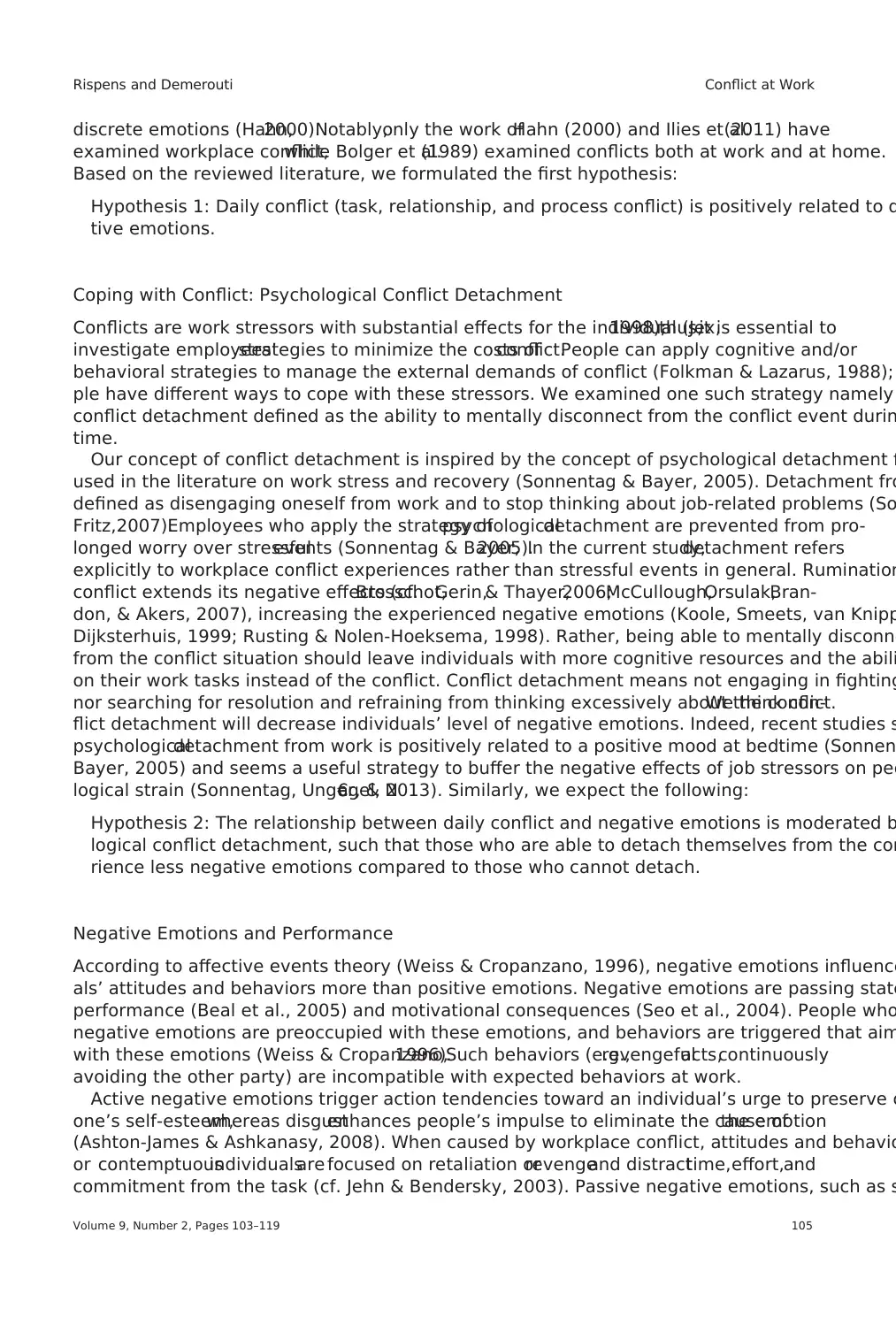
discrete emotions (Hahn,2000).Notably,only the work ofHahn (2000) and Ilies et al.(2011) have
examined workplace conflict,while Bolger et al.(1989) examined conflicts both at work and at home.
Based on the reviewed literature, we formulated the first hypothesis:
Hypothesis 1: Daily conflict (task, relationship, and process conflict) is positively related to d
tive emotions.
Coping with Conflict: Psychological Conflict Detachment
Conflicts are work stressors with substantial effects for the individual (Jex,1998);thus,it is essential to
investigate employees’strategies to minimize the costs ofconflict.People can apply cognitive and/or
behavioral strategies to manage the external demands of conflict (Folkman & Lazarus, 1988);
ple have different ways to cope with these stressors. We examined one such strategy namely
conflict detachment defined as the ability to mentally disconnect from the conflict event durin
time.
Our concept of conflict detachment is inspired by the concept of psychological detachment f
used in the literature on work stress and recovery (Sonnentag & Bayer, 2005). Detachment fro
defined as disengaging oneself from work and to stop thinking about job-related problems (So
Fritz,2007).Employees who apply the strategy ofpsychologicaldetachment are prevented from pro-
longed worry over stressfulevents (Sonnentag & Bayer,2005).In the current study,detachment refers
explicitly to workplace conflict experiences rather than stressful events in general. Rumination
conflict extends its negative effects (cf.Brosschot,Gerin,& Thayer,2006;McCullough,Orsulak,Bran-
don, & Akers, 2007), increasing the experienced negative emotions (Koole, Smeets, van Knipp
Dijksterhuis, 1999; Rusting & Nolen-Hoeksema, 1998). Rather, being able to mentally disconne
from the conflict situation should leave individuals with more cognitive resources and the abili
on their work tasks instead of the conflict. Conflict detachment means not engaging in fighting
nor searching for resolution and refraining from thinking excessively about the conflict.We think con-
flict detachment will decrease individuals’ level of negative emotions. Indeed, recent studies s
psychologicaldetachment from work is positively related to a positive mood at bedtime (Sonnen
Bayer, 2005) and seems a useful strategy to buffer the negative effects of job stressors on peo
logical strain (Sonnentag, Unger, & N€agel, 2013). Similarly, we expect the following:
Hypothesis 2: The relationship between daily conflict and negative emotions is moderated b
logical conflict detachment, such that those who are able to detach themselves from the con
rience less negative emotions compared to those who cannot detach.
Negative Emotions and Performance
According to affective events theory (Weiss & Cropanzano, 1996), negative emotions influence
als’ attitudes and behaviors more than positive emotions. Negative emotions are passing state
performance (Beal et al., 2005) and motivational consequences (Seo et al., 2004). People who
negative emotions are preoccupied with these emotions, and behaviors are triggered that aim
with these emotions (Weiss & Cropanzano,1996).Such behaviors (e.g.,revengefulacts,continuously
avoiding the other party) are incompatible with expected behaviors at work.
Active negative emotions trigger action tendencies toward an individual’s urge to preserve o
one’s self-esteem,whereas disgustenhances people’s impulse to eliminate the cause ofthe emotion
(Ashton-James & Ashkanasy, 2008). When caused by workplace conflict, attitudes and behavio
or contemptuousindividualsare focused on retaliation orrevengeand distracttime,effort,and
commitment from the task (cf. Jehn & Bendersky, 2003). Passive negative emotions, such as s
Volume 9, Number 2, Pages 103–119 105
Rispens and Demerouti Conflict at Work
examined workplace conflict,while Bolger et al.(1989) examined conflicts both at work and at home.
Based on the reviewed literature, we formulated the first hypothesis:
Hypothesis 1: Daily conflict (task, relationship, and process conflict) is positively related to d
tive emotions.
Coping with Conflict: Psychological Conflict Detachment
Conflicts are work stressors with substantial effects for the individual (Jex,1998);thus,it is essential to
investigate employees’strategies to minimize the costs ofconflict.People can apply cognitive and/or
behavioral strategies to manage the external demands of conflict (Folkman & Lazarus, 1988);
ple have different ways to cope with these stressors. We examined one such strategy namely
conflict detachment defined as the ability to mentally disconnect from the conflict event durin
time.
Our concept of conflict detachment is inspired by the concept of psychological detachment f
used in the literature on work stress and recovery (Sonnentag & Bayer, 2005). Detachment fro
defined as disengaging oneself from work and to stop thinking about job-related problems (So
Fritz,2007).Employees who apply the strategy ofpsychologicaldetachment are prevented from pro-
longed worry over stressfulevents (Sonnentag & Bayer,2005).In the current study,detachment refers
explicitly to workplace conflict experiences rather than stressful events in general. Rumination
conflict extends its negative effects (cf.Brosschot,Gerin,& Thayer,2006;McCullough,Orsulak,Bran-
don, & Akers, 2007), increasing the experienced negative emotions (Koole, Smeets, van Knipp
Dijksterhuis, 1999; Rusting & Nolen-Hoeksema, 1998). Rather, being able to mentally disconne
from the conflict situation should leave individuals with more cognitive resources and the abili
on their work tasks instead of the conflict. Conflict detachment means not engaging in fighting
nor searching for resolution and refraining from thinking excessively about the conflict.We think con-
flict detachment will decrease individuals’ level of negative emotions. Indeed, recent studies s
psychologicaldetachment from work is positively related to a positive mood at bedtime (Sonnen
Bayer, 2005) and seems a useful strategy to buffer the negative effects of job stressors on peo
logical strain (Sonnentag, Unger, & N€agel, 2013). Similarly, we expect the following:
Hypothesis 2: The relationship between daily conflict and negative emotions is moderated b
logical conflict detachment, such that those who are able to detach themselves from the con
rience less negative emotions compared to those who cannot detach.
Negative Emotions and Performance
According to affective events theory (Weiss & Cropanzano, 1996), negative emotions influence
als’ attitudes and behaviors more than positive emotions. Negative emotions are passing state
performance (Beal et al., 2005) and motivational consequences (Seo et al., 2004). People who
negative emotions are preoccupied with these emotions, and behaviors are triggered that aim
with these emotions (Weiss & Cropanzano,1996).Such behaviors (e.g.,revengefulacts,continuously
avoiding the other party) are incompatible with expected behaviors at work.
Active negative emotions trigger action tendencies toward an individual’s urge to preserve o
one’s self-esteem,whereas disgustenhances people’s impulse to eliminate the cause ofthe emotion
(Ashton-James & Ashkanasy, 2008). When caused by workplace conflict, attitudes and behavio
or contemptuousindividualsare focused on retaliation orrevengeand distracttime,effort,and
commitment from the task (cf. Jehn & Bendersky, 2003). Passive negative emotions, such as s
Volume 9, Number 2, Pages 103–119 105
Rispens and Demerouti Conflict at Work
Paraphrase This Document
Need a fresh take? Get an instant paraphrase of this document with our AI Paraphraser
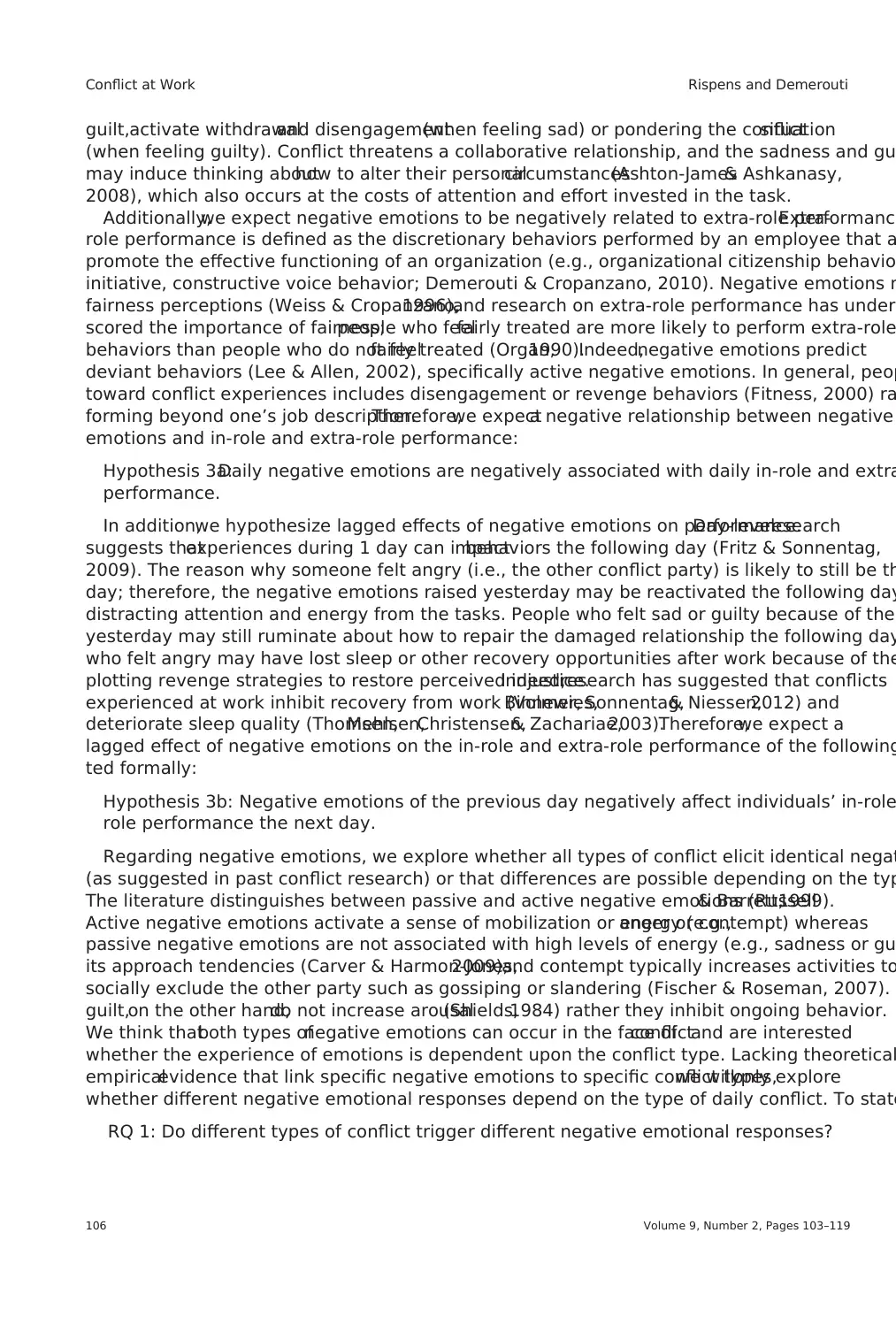
guilt,activate withdrawaland disengagement(when feeling sad) or pondering the conflictsituation
(when feeling guilty). Conflict threatens a collaborative relationship, and the sadness and gu
may induce thinking abouthow to alter their personalcircumstances(Ashton-James& Ashkanasy,
2008), which also occurs at the costs of attention and effort invested in the task.
Additionally,we expect negative emotions to be negatively related to extra-role performanceExtra-
role performance is defined as the discretionary behaviors performed by an employee that a
promote the effective functioning of an organization (e.g., organizational citizenship behavio
initiative, constructive voice behavior; Demerouti & Cropanzano, 2010). Negative emotions m
fairness perceptions (Weiss & Cropanzano,1996),and research on extra-role performance has under
scored the importance of fairness;people who feelfairly treated are more likely to perform extra-role
behaviors than people who do not feelfairly treated (Organ,1990).Indeed,negative emotions predict
deviant behaviors (Lee & Allen, 2002), specifically active negative emotions. In general, peop
toward conflict experiences includes disengagement or revenge behaviors (Fitness, 2000) ra
forming beyond one’s job description.Therefore,we expecta negative relationship between negative
emotions and in-role and extra-role performance:
Hypothesis 3a:Daily negative emotions are negatively associated with daily in-role and extra
performance.
In addition,we hypothesize lagged effects of negative emotions on performance.Day-levelresearch
suggests thatexperiences during 1 day can impactbehaviors the following day (Fritz & Sonnentag,
2009). The reason why someone felt angry (i.e., the other conflict party) is likely to still be th
day; therefore, the negative emotions raised yesterday may be reactivated the following day
distracting attention and energy from the tasks. People who felt sad or guilty because of the
yesterday may still ruminate about how to repair the damaged relationship the following day
who felt angry may have lost sleep or other recovery opportunities after work because of the
plotting revenge strategies to restore perceived injustice.Indeed,research has suggested that conflicts
experienced at work inhibit recovery from work (Volmer,Binnewies,Sonnentag,& Niessen,2012) and
deteriorate sleep quality (Thomsen,Mehlsen,Christensen,& Zachariae,2003).Therefore,we expect a
lagged effect of negative emotions on the in-role and extra-role performance of the following
ted formally:
Hypothesis 3b: Negative emotions of the previous day negatively affect individuals’ in-role
role performance the next day.
Regarding negative emotions, we explore whether all types of conflict elicit identical negat
(as suggested in past conflict research) or that differences are possible depending on the typ
The literature distinguishes between passive and active negative emotions (Russell& Barrett,1999).
Active negative emotions activate a sense of mobilization or energy (e.g.,anger or contempt) whereas
passive negative emotions are not associated with high levels of energy (e.g., sadness or gu
its approach tendencies (Carver & Harmon-Jones,2009),and contempt typically increases activities to
socially exclude the other party such as gossiping or slandering (Fischer & Roseman, 2007).
guilt,on the other hand,do not increase arousal(Shields,1984) rather they inhibit ongoing behavior.
We think thatboth types ofnegative emotions can occur in the face ofconflictand are interested
whether the experience of emotions is dependent upon the conflict type. Lacking theoretical
empiricalevidence that link specific negative emotions to specific conflict types,we willonly explore
whether different negative emotional responses depend on the type of daily conflict. To state
RQ 1: Do different types of conflict trigger different negative emotional responses?
Volume 9, Number 2, Pages 103–119106
Conflict at Work Rispens and Demerouti
(when feeling guilty). Conflict threatens a collaborative relationship, and the sadness and gu
may induce thinking abouthow to alter their personalcircumstances(Ashton-James& Ashkanasy,
2008), which also occurs at the costs of attention and effort invested in the task.
Additionally,we expect negative emotions to be negatively related to extra-role performanceExtra-
role performance is defined as the discretionary behaviors performed by an employee that a
promote the effective functioning of an organization (e.g., organizational citizenship behavio
initiative, constructive voice behavior; Demerouti & Cropanzano, 2010). Negative emotions m
fairness perceptions (Weiss & Cropanzano,1996),and research on extra-role performance has under
scored the importance of fairness;people who feelfairly treated are more likely to perform extra-role
behaviors than people who do not feelfairly treated (Organ,1990).Indeed,negative emotions predict
deviant behaviors (Lee & Allen, 2002), specifically active negative emotions. In general, peop
toward conflict experiences includes disengagement or revenge behaviors (Fitness, 2000) ra
forming beyond one’s job description.Therefore,we expecta negative relationship between negative
emotions and in-role and extra-role performance:
Hypothesis 3a:Daily negative emotions are negatively associated with daily in-role and extra
performance.
In addition,we hypothesize lagged effects of negative emotions on performance.Day-levelresearch
suggests thatexperiences during 1 day can impactbehaviors the following day (Fritz & Sonnentag,
2009). The reason why someone felt angry (i.e., the other conflict party) is likely to still be th
day; therefore, the negative emotions raised yesterday may be reactivated the following day
distracting attention and energy from the tasks. People who felt sad or guilty because of the
yesterday may still ruminate about how to repair the damaged relationship the following day
who felt angry may have lost sleep or other recovery opportunities after work because of the
plotting revenge strategies to restore perceived injustice.Indeed,research has suggested that conflicts
experienced at work inhibit recovery from work (Volmer,Binnewies,Sonnentag,& Niessen,2012) and
deteriorate sleep quality (Thomsen,Mehlsen,Christensen,& Zachariae,2003).Therefore,we expect a
lagged effect of negative emotions on the in-role and extra-role performance of the following
ted formally:
Hypothesis 3b: Negative emotions of the previous day negatively affect individuals’ in-role
role performance the next day.
Regarding negative emotions, we explore whether all types of conflict elicit identical negat
(as suggested in past conflict research) or that differences are possible depending on the typ
The literature distinguishes between passive and active negative emotions (Russell& Barrett,1999).
Active negative emotions activate a sense of mobilization or energy (e.g.,anger or contempt) whereas
passive negative emotions are not associated with high levels of energy (e.g., sadness or gu
its approach tendencies (Carver & Harmon-Jones,2009),and contempt typically increases activities to
socially exclude the other party such as gossiping or slandering (Fischer & Roseman, 2007).
guilt,on the other hand,do not increase arousal(Shields,1984) rather they inhibit ongoing behavior.
We think thatboth types ofnegative emotions can occur in the face ofconflictand are interested
whether the experience of emotions is dependent upon the conflict type. Lacking theoretical
empiricalevidence that link specific negative emotions to specific conflict types,we willonly explore
whether different negative emotional responses depend on the type of daily conflict. To state
RQ 1: Do different types of conflict trigger different negative emotional responses?
Volume 9, Number 2, Pages 103–119106
Conflict at Work Rispens and Demerouti
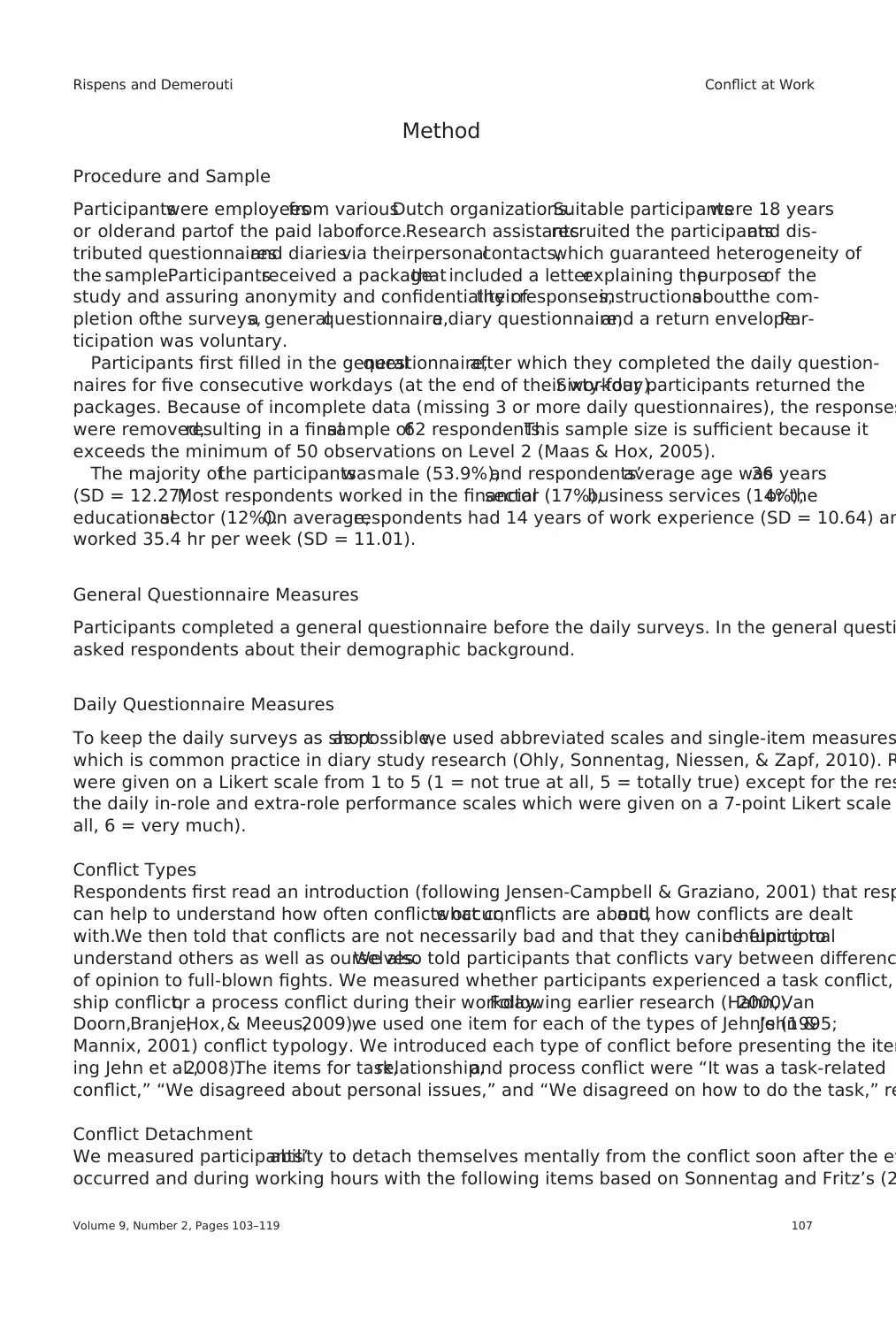
Method
Procedure and Sample
Participantswere employeesfrom variousDutch organizations.Suitable participantswere 18 years
or olderand partof the paid laborforce.Research assistantsrecruited the participantsand dis-
tributed questionnairesand diariesvia theirpersonalcontacts,which guaranteed heterogeneity of
the sample.Participantsreceived a packagethat included a letterexplaining thepurposeof the
study and assuring anonymity and confidentiality oftheirresponses,instructionsaboutthe com-
pletion ofthe surveys,a generalquestionnaire,a diary questionnaire,and a return envelope.Par-
ticipation was voluntary.
Participants first filled in the generalquestionnaire,after which they completed the daily question-
naires for five consecutive workdays (at the end of their workday).Sixty-four participants returned the
packages. Because of incomplete data (missing 3 or more daily questionnaires), the responses
were removed,resulting in a finalsample of62 respondents.This sample size is sufficient because it
exceeds the minimum of 50 observations on Level 2 (Maas & Hox, 2005).
The majority ofthe participantswasmale (53.9%),and respondents’average age was36 years
(SD = 12.27).Most respondents worked in the financialsector (17%),business services (14%),or the
educationalsector (12%).On average,respondents had 14 years of work experience (SD = 10.64) an
worked 35.4 hr per week (SD = 11.01).
General Questionnaire Measures
Participants completed a general questionnaire before the daily surveys. In the general questi
asked respondents about their demographic background.
Daily Questionnaire Measures
To keep the daily surveys as shortas possible,we used abbreviated scales and single-item measures
which is common practice in diary study research (Ohly, Sonnentag, Niessen, & Zapf, 2010). R
were given on a Likert scale from 1 to 5 (1 = not true at all, 5 = totally true) except for the res
the daily in-role and extra-role performance scales which were given on a 7-point Likert scale
all, 6 = very much).
Conflict Types
Respondents first read an introduction (following Jensen-Campbell & Graziano, 2001) that resp
can help to understand how often conflicts occur,what conflicts are about,and how conflicts are dealt
with.We then told that conflicts are not necessarily bad and that they can be functionalin helping to
understand others as well as ourselves.We also told participants that conflicts vary between differenc
of opinion to full-blown fights. We measured whether participants experienced a task conflict,
ship conflict,or a process conflict during their workday.Following earlier research (Hahn,2000;Van
Doorn,Branje,Hox,& Meeus,2009),we used one item for each of the types of Jehn’s (1995;Jehn &
Mannix, 2001) conflict typology. We introduced each type of conflict before presenting the item
ing Jehn et al.,2008).The items for task,relationship,and process conflict were “It was a task-related
conflict,” “We disagreed about personal issues,” and “We disagreed on how to do the task,” re
Conflict Detachment
We measured participants’ability to detach themselves mentally from the conflict soon after the ev
occurred and during working hours with the following items based on Sonnentag and Fritz’s (2
Volume 9, Number 2, Pages 103–119 107
Rispens and Demerouti Conflict at Work
Procedure and Sample
Participantswere employeesfrom variousDutch organizations.Suitable participantswere 18 years
or olderand partof the paid laborforce.Research assistantsrecruited the participantsand dis-
tributed questionnairesand diariesvia theirpersonalcontacts,which guaranteed heterogeneity of
the sample.Participantsreceived a packagethat included a letterexplaining thepurposeof the
study and assuring anonymity and confidentiality oftheirresponses,instructionsaboutthe com-
pletion ofthe surveys,a generalquestionnaire,a diary questionnaire,and a return envelope.Par-
ticipation was voluntary.
Participants first filled in the generalquestionnaire,after which they completed the daily question-
naires for five consecutive workdays (at the end of their workday).Sixty-four participants returned the
packages. Because of incomplete data (missing 3 or more daily questionnaires), the responses
were removed,resulting in a finalsample of62 respondents.This sample size is sufficient because it
exceeds the minimum of 50 observations on Level 2 (Maas & Hox, 2005).
The majority ofthe participantswasmale (53.9%),and respondents’average age was36 years
(SD = 12.27).Most respondents worked in the financialsector (17%),business services (14%),or the
educationalsector (12%).On average,respondents had 14 years of work experience (SD = 10.64) an
worked 35.4 hr per week (SD = 11.01).
General Questionnaire Measures
Participants completed a general questionnaire before the daily surveys. In the general questi
asked respondents about their demographic background.
Daily Questionnaire Measures
To keep the daily surveys as shortas possible,we used abbreviated scales and single-item measures
which is common practice in diary study research (Ohly, Sonnentag, Niessen, & Zapf, 2010). R
were given on a Likert scale from 1 to 5 (1 = not true at all, 5 = totally true) except for the res
the daily in-role and extra-role performance scales which were given on a 7-point Likert scale
all, 6 = very much).
Conflict Types
Respondents first read an introduction (following Jensen-Campbell & Graziano, 2001) that resp
can help to understand how often conflicts occur,what conflicts are about,and how conflicts are dealt
with.We then told that conflicts are not necessarily bad and that they can be functionalin helping to
understand others as well as ourselves.We also told participants that conflicts vary between differenc
of opinion to full-blown fights. We measured whether participants experienced a task conflict,
ship conflict,or a process conflict during their workday.Following earlier research (Hahn,2000;Van
Doorn,Branje,Hox,& Meeus,2009),we used one item for each of the types of Jehn’s (1995;Jehn &
Mannix, 2001) conflict typology. We introduced each type of conflict before presenting the item
ing Jehn et al.,2008).The items for task,relationship,and process conflict were “It was a task-related
conflict,” “We disagreed about personal issues,” and “We disagreed on how to do the task,” re
Conflict Detachment
We measured participants’ability to detach themselves mentally from the conflict soon after the ev
occurred and during working hours with the following items based on Sonnentag and Fritz’s (2
Volume 9, Number 2, Pages 103–119 107
Rispens and Demerouti Conflict at Work
⊘ This is a preview!⊘
Do you want full access?
Subscribe today to unlock all pages.

Trusted by 1+ million students worldwide
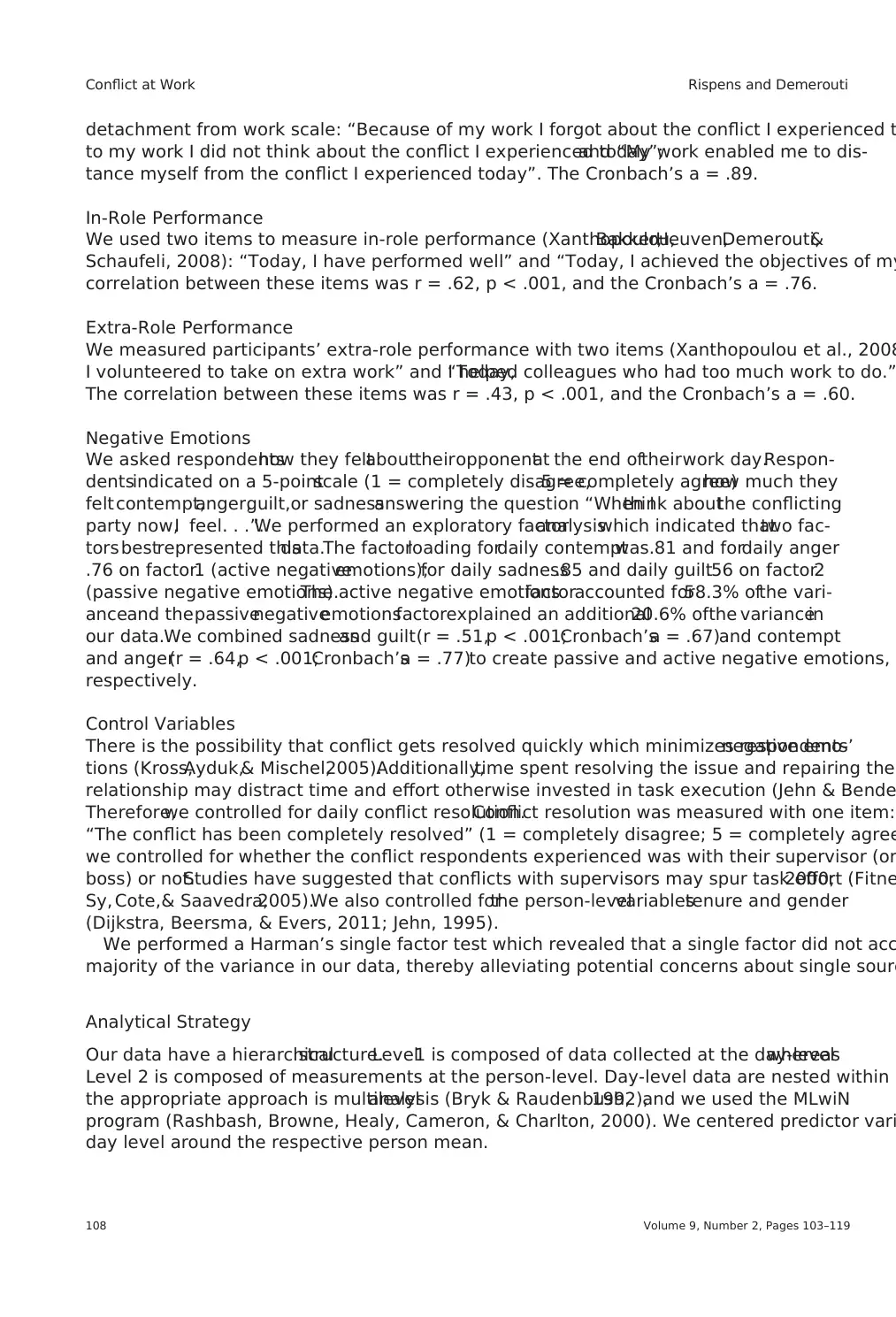
detachment from work scale: “Because of my work I forgot about the conflict I experienced t
to my work I did not think about the conflict I experienced today”;and “My work enabled me to dis-
tance myself from the conflict I experienced today”. The Cronbach’s a = .89.
In-Role Performance
We used two items to measure in-role performance (Xanthopoulou,Bakker,Heuven,Demerouti,&
Schaufeli, 2008): “Today, I have performed well” and “Today, I achieved the objectives of my
correlation between these items was r = .62, p < .001, and the Cronbach’s a = .76.
Extra-Role Performance
We measured participants’ extra-role performance with two items (Xanthopoulou et al., 2008
I volunteered to take on extra work” and “Today,I helped colleagues who had too much work to do.”
The correlation between these items was r = .43, p < .001, and the Cronbach’s a = .60.
Negative Emotions
We asked respondentshow they feltabouttheiropponentat the end oftheirwork day.Respon-
dentsindicated on a 5-pointscale (1 = completely disagree,5 = completely agree)how much they
feltcontempt,anger,guilt,or sadnessanswering the question “When Ithink aboutthe conflicting
party now,I feel. . .”.We performed an exploratory factoranalysiswhich indicated thattwo fac-
tors bestrepresented thisdata.The factorloading fordaily contemptwas.81 and fordaily anger
.76 on factor1 (active negativeemotions);for daily sadness.85 and daily guilt.56 on factor2
(passive negative emotions).The active negative emotionsfactoraccounted for58.3% ofthe vari-
anceand thepassivenegativeemotionsfactorexplained an additional20.6% ofthe variancein
our data.We combined sadnessand guilt(r = .51,p < .001;Cronbach’sa = .67)and contempt
and anger(r = .64,p < .001;Cronbach’sa = .77)to create passive and active negative emotions,
respectively.
Control Variables
There is the possibility that conflict gets resolved quickly which minimizes respondents’negative emo-
tions (Kross,Ayduk,& Mischel,2005).Additionally,time spent resolving the issue and repairing the
relationship may distract time and effort otherwise invested in task execution (Jehn & Bende
Therefore,we controlled for daily conflict resolution.Conflict resolution was measured with one item:
“The conflict has been completely resolved” (1 = completely disagree; 5 = completely agree
we controlled for whether the conflict respondents experienced was with their supervisor (or
boss) or not.Studies have suggested that conflicts with supervisors may spur task effort (Fitne2000;
Sy, Cote,& Saavedra,2005).We also controlled forthe person-levelvariablestenure and gender
(Dijkstra, Beersma, & Evers, 2011; Jehn, 1995).
We performed a Harman’s single factor test which revealed that a single factor did not acc
majority of the variance in our data, thereby alleviating potential concerns about single sourc
Analytical Strategy
Our data have a hierarchicalstructure.Level1 is composed of data collected at the day-levelwhereas
Level 2 is composed of measurements at the person-level. Day-level data are nested within p
the appropriate approach is multilevelanalysis (Bryk & Raudenbush,1992),and we used the MLwiN
program (Rashbash, Browne, Healy, Cameron, & Charlton, 2000). We centered predictor vari
day level around the respective person mean.
Volume 9, Number 2, Pages 103–119108
Conflict at Work Rispens and Demerouti
to my work I did not think about the conflict I experienced today”;and “My work enabled me to dis-
tance myself from the conflict I experienced today”. The Cronbach’s a = .89.
In-Role Performance
We used two items to measure in-role performance (Xanthopoulou,Bakker,Heuven,Demerouti,&
Schaufeli, 2008): “Today, I have performed well” and “Today, I achieved the objectives of my
correlation between these items was r = .62, p < .001, and the Cronbach’s a = .76.
Extra-Role Performance
We measured participants’ extra-role performance with two items (Xanthopoulou et al., 2008
I volunteered to take on extra work” and “Today,I helped colleagues who had too much work to do.”
The correlation between these items was r = .43, p < .001, and the Cronbach’s a = .60.
Negative Emotions
We asked respondentshow they feltabouttheiropponentat the end oftheirwork day.Respon-
dentsindicated on a 5-pointscale (1 = completely disagree,5 = completely agree)how much they
feltcontempt,anger,guilt,or sadnessanswering the question “When Ithink aboutthe conflicting
party now,I feel. . .”.We performed an exploratory factoranalysiswhich indicated thattwo fac-
tors bestrepresented thisdata.The factorloading fordaily contemptwas.81 and fordaily anger
.76 on factor1 (active negativeemotions);for daily sadness.85 and daily guilt.56 on factor2
(passive negative emotions).The active negative emotionsfactoraccounted for58.3% ofthe vari-
anceand thepassivenegativeemotionsfactorexplained an additional20.6% ofthe variancein
our data.We combined sadnessand guilt(r = .51,p < .001;Cronbach’sa = .67)and contempt
and anger(r = .64,p < .001;Cronbach’sa = .77)to create passive and active negative emotions,
respectively.
Control Variables
There is the possibility that conflict gets resolved quickly which minimizes respondents’negative emo-
tions (Kross,Ayduk,& Mischel,2005).Additionally,time spent resolving the issue and repairing the
relationship may distract time and effort otherwise invested in task execution (Jehn & Bende
Therefore,we controlled for daily conflict resolution.Conflict resolution was measured with one item:
“The conflict has been completely resolved” (1 = completely disagree; 5 = completely agree
we controlled for whether the conflict respondents experienced was with their supervisor (or
boss) or not.Studies have suggested that conflicts with supervisors may spur task effort (Fitne2000;
Sy, Cote,& Saavedra,2005).We also controlled forthe person-levelvariablestenure and gender
(Dijkstra, Beersma, & Evers, 2011; Jehn, 1995).
We performed a Harman’s single factor test which revealed that a single factor did not acc
majority of the variance in our data, thereby alleviating potential concerns about single sourc
Analytical Strategy
Our data have a hierarchicalstructure.Level1 is composed of data collected at the day-levelwhereas
Level 2 is composed of measurements at the person-level. Day-level data are nested within p
the appropriate approach is multilevelanalysis (Bryk & Raudenbush,1992),and we used the MLwiN
program (Rashbash, Browne, Healy, Cameron, & Charlton, 2000). We centered predictor vari
day level around the respective person mean.
Volume 9, Number 2, Pages 103–119108
Conflict at Work Rispens and Demerouti
Paraphrase This Document
Need a fresh take? Get an instant paraphrase of this document with our AI Paraphraser
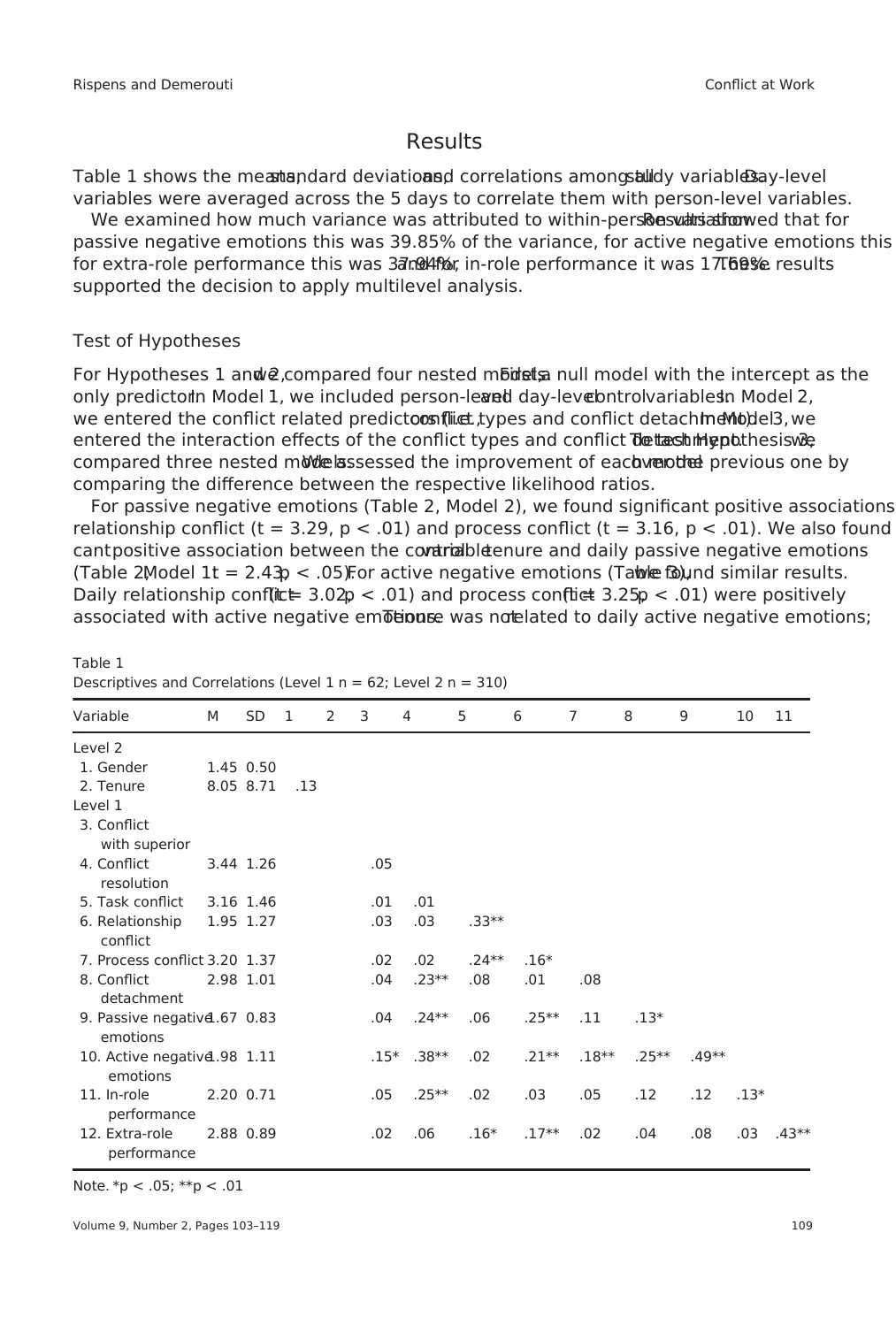
Results
Table 1 shows the means,standard deviations,and correlations among allstudy variables.Day-level
variables were averaged across the 5 days to correlate them with person-level variables.
We examined how much variance was attributed to within-person variation.Results showed that for
passive negative emotions this was 39.85% of the variance, for active negative emotions this
for extra-role performance this was 37.94%,and for in-role performance it was 17.69%.These results
supported the decision to apply multilevel analysis.
Test of Hypotheses
For Hypotheses 1 and 2,we compared four nested models.First,a null model with the intercept as the
only predictor.In Model 1, we included person-leveland day-levelcontrolvariables.In Model 2,
we entered the conflict related predictors (i.e.,conflict types and conflict detachment).In Model3, we
entered the interaction effects of the conflict types and conflict detachment.To test Hypothesis 3,we
compared three nested models.We assessed the improvement of each modelover the previous one by
comparing the difference between the respective likelihood ratios.
For passive negative emotions (Table 2, Model 2), we found significant positive associations
relationship conflict (t = 3.29, p < .01) and process conflict (t = 3.16, p < .01). We also found
cantpositive association between the controlvariabletenure and daily passive negative emotions
(Table 2,Model 1:t = 2.43,p < .05).For active negative emotions (Table 3),we found similar results.
Daily relationship conflict(t = 3.02,p < .01) and process conflict(t = 3.25,p < .01) were positively
associated with active negative emotions.Tenure was notrelated to daily active negative emotions;
Table 1
Descriptives and Correlations (Level 1 n = 62; Level 2 n = 310)
Variable M SD 1 2 3 4 5 6 7 8 9 10 11
Level 2
1. Gender 1.45 0.50
2. Tenure 8.05 8.71 .13
Level 1
3. Conflict
with superior
4. Conflict
resolution
3.44 1.26 .05
5. Task conflict 3.16 1.46 .01 .01
6. Relationship
conflict
1.95 1.27 .03 .03 .33**
7. Process conflict 3.20 1.37 .02 .02 .24** .16*
8. Conflict
detachment
2.98 1.01 .04 .23** .08 .01 .08
9. Passive negative
emotions
1.67 0.83 .04 .24** .06 .25** .11 .13*
10. Active negative
emotions
1.98 1.11 .15* .38** .02 .21** .18** .25** .49**
11. In-role
performance
2.20 0.71 .05 .25** .02 .03 .05 .12 .12 .13*
12. Extra-role
performance
2.88 0.89 .02 .06 .16* .17** .02 .04 .08 .03 .43**
Note. *p < .05; **p < .01
Volume 9, Number 2, Pages 103–119 109
Rispens and Demerouti Conflict at Work
Table 1 shows the means,standard deviations,and correlations among allstudy variables.Day-level
variables were averaged across the 5 days to correlate them with person-level variables.
We examined how much variance was attributed to within-person variation.Results showed that for
passive negative emotions this was 39.85% of the variance, for active negative emotions this
for extra-role performance this was 37.94%,and for in-role performance it was 17.69%.These results
supported the decision to apply multilevel analysis.
Test of Hypotheses
For Hypotheses 1 and 2,we compared four nested models.First,a null model with the intercept as the
only predictor.In Model 1, we included person-leveland day-levelcontrolvariables.In Model 2,
we entered the conflict related predictors (i.e.,conflict types and conflict detachment).In Model3, we
entered the interaction effects of the conflict types and conflict detachment.To test Hypothesis 3,we
compared three nested models.We assessed the improvement of each modelover the previous one by
comparing the difference between the respective likelihood ratios.
For passive negative emotions (Table 2, Model 2), we found significant positive associations
relationship conflict (t = 3.29, p < .01) and process conflict (t = 3.16, p < .01). We also found
cantpositive association between the controlvariabletenure and daily passive negative emotions
(Table 2,Model 1:t = 2.43,p < .05).For active negative emotions (Table 3),we found similar results.
Daily relationship conflict(t = 3.02,p < .01) and process conflict(t = 3.25,p < .01) were positively
associated with active negative emotions.Tenure was notrelated to daily active negative emotions;
Table 1
Descriptives and Correlations (Level 1 n = 62; Level 2 n = 310)
Variable M SD 1 2 3 4 5 6 7 8 9 10 11
Level 2
1. Gender 1.45 0.50
2. Tenure 8.05 8.71 .13
Level 1
3. Conflict
with superior
4. Conflict
resolution
3.44 1.26 .05
5. Task conflict 3.16 1.46 .01 .01
6. Relationship
conflict
1.95 1.27 .03 .03 .33**
7. Process conflict 3.20 1.37 .02 .02 .24** .16*
8. Conflict
detachment
2.98 1.01 .04 .23** .08 .01 .08
9. Passive negative
emotions
1.67 0.83 .04 .24** .06 .25** .11 .13*
10. Active negative
emotions
1.98 1.11 .15* .38** .02 .21** .18** .25** .49**
11. In-role
performance
2.20 0.71 .05 .25** .02 .03 .05 .12 .12 .13*
12. Extra-role
performance
2.88 0.89 .02 .06 .16* .17** .02 .04 .08 .03 .43**
Note. *p < .05; **p < .01
Volume 9, Number 2, Pages 103–119 109
Rispens and Demerouti Conflict at Work
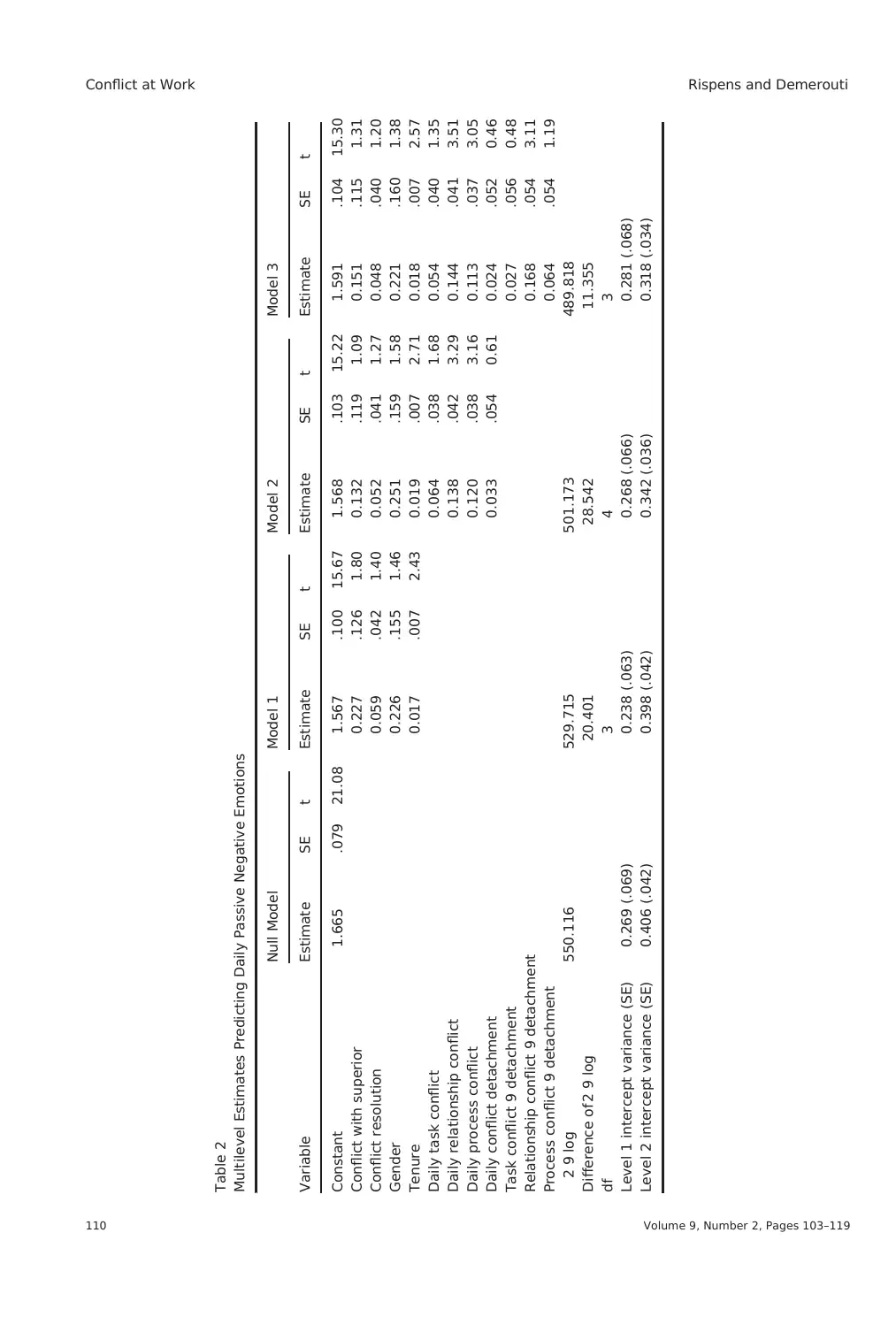
Table 2
Multilevel Estimates Predicting Daily Passive Negative Emotions
Variable
Null Model Model 1 Model 2 Model 3
Estimate SE t Estimate SE t Estimate SE t Estimate SE t
Constant 1.665 .079 21.08 1.567 .100 15.67 1.568 .103 15.22 1.591 .104 15.30
Conflict with superior 0.227 .126 1.80 0.132 .119 1.09 0.151 .115 1.31
Conflict resolution 0.059 .042 1.40 0.052 .041 1.27 0.048 .040 1.20
Gender 0.226 .155 1.46 0.251 .159 1.58 0.221 .160 1.38
Tenure 0.017 .007 2.43 0.019 .007 2.71 0.018 .007 2.57
Daily task conflict 0.064 .038 1.68 0.054 .040 1.35
Daily relationship conflict 0.138 .042 3.29 0.144 .041 3.51
Daily process conflict 0.120 .038 3.16 0.113 .037 3.05
Daily conflict detachment 0.033 .054 0.61 0.024 .052 0.46
Task conflict 9 detachment 0.027 .056 0.48
Relationship conflict 9 detachment 0.168 .054 3.11
Process conflict 9 detachment 0.064 .054 1.19
2 9 log 550.116 529.715 501.173 489.818
Difference of 2 9 log 20.401 28.542 11.355
df 3 4 3
Level 1 intercept variance (SE) 0.269 (.069) 0.238 (.063) 0.268 (.066) 0.281 (.068)
Level 2 intercept variance (SE) 0.406 (.042) 0.398 (.042) 0.342 (.036) 0.318 (.034)
Volume 9, Number 2, Pages 103–119110
Conflict at Work Rispens and Demerouti
Multilevel Estimates Predicting Daily Passive Negative Emotions
Variable
Null Model Model 1 Model 2 Model 3
Estimate SE t Estimate SE t Estimate SE t Estimate SE t
Constant 1.665 .079 21.08 1.567 .100 15.67 1.568 .103 15.22 1.591 .104 15.30
Conflict with superior 0.227 .126 1.80 0.132 .119 1.09 0.151 .115 1.31
Conflict resolution 0.059 .042 1.40 0.052 .041 1.27 0.048 .040 1.20
Gender 0.226 .155 1.46 0.251 .159 1.58 0.221 .160 1.38
Tenure 0.017 .007 2.43 0.019 .007 2.71 0.018 .007 2.57
Daily task conflict 0.064 .038 1.68 0.054 .040 1.35
Daily relationship conflict 0.138 .042 3.29 0.144 .041 3.51
Daily process conflict 0.120 .038 3.16 0.113 .037 3.05
Daily conflict detachment 0.033 .054 0.61 0.024 .052 0.46
Task conflict 9 detachment 0.027 .056 0.48
Relationship conflict 9 detachment 0.168 .054 3.11
Process conflict 9 detachment 0.064 .054 1.19
2 9 log 550.116 529.715 501.173 489.818
Difference of 2 9 log 20.401 28.542 11.355
df 3 4 3
Level 1 intercept variance (SE) 0.269 (.069) 0.238 (.063) 0.268 (.066) 0.281 (.068)
Level 2 intercept variance (SE) 0.406 (.042) 0.398 (.042) 0.342 (.036) 0.318 (.034)
Volume 9, Number 2, Pages 103–119110
Conflict at Work Rispens and Demerouti
⊘ This is a preview!⊘
Do you want full access?
Subscribe today to unlock all pages.

Trusted by 1+ million students worldwide
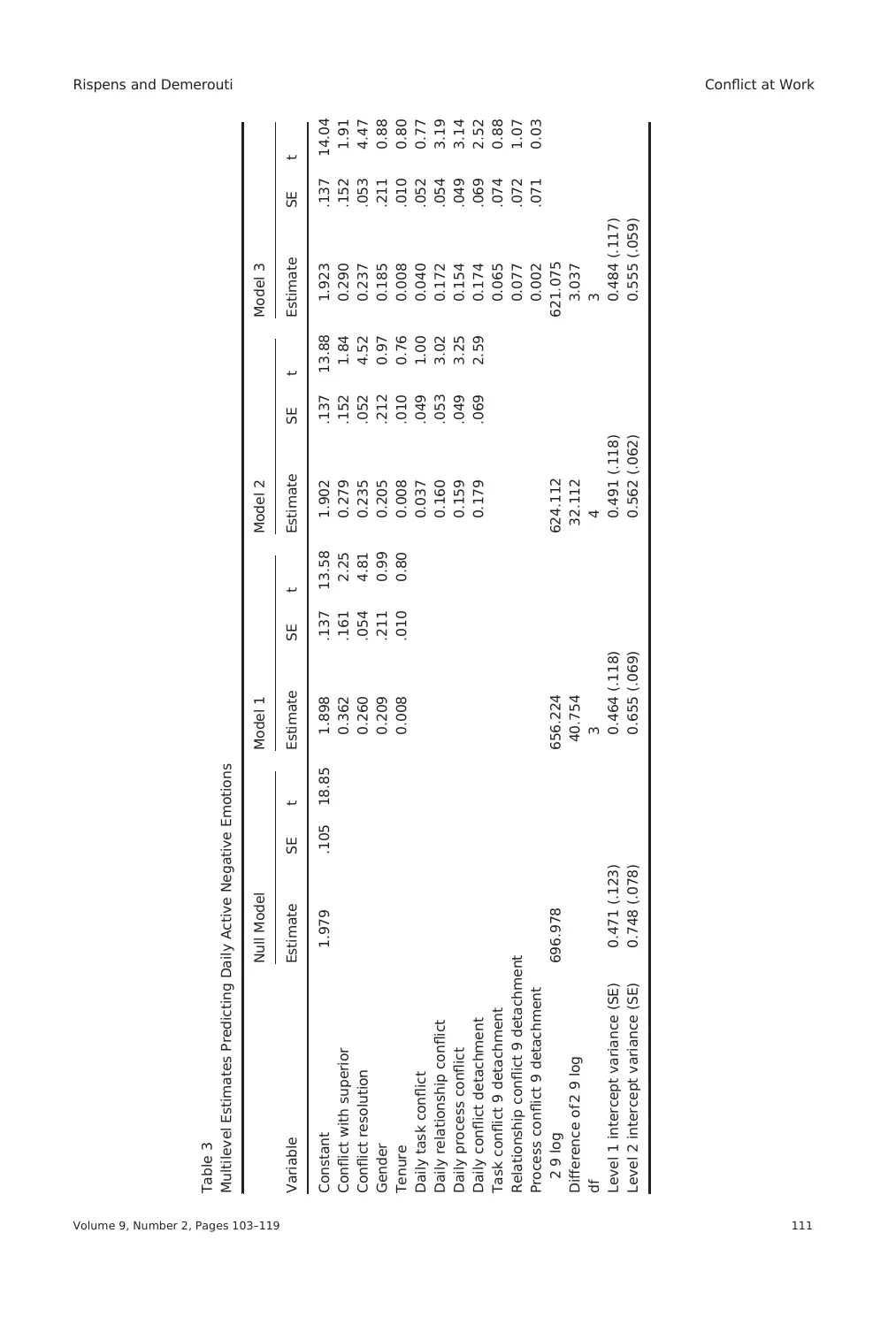
Table 3
Multilevel Estimates Predicting Daily Active Negative Emotions
Variable
Null Model Model 1 Model 2 Model 3
Estimate SE t Estimate SE t Estimate SE t Estimate SE t
Constant 1.979 .105 18.85 1.898 .137 13.58 1.902 .137 13.88 1.923 .137 14.04
Conflict with superior 0.362 .161 2.25 0.279 .152 1.84 0.290 .152 1.91
Conflict resolution 0.260 .054 4.81 0.235 .052 4.52 0.237 .053 4.47
Gender 0.209 .211 0.99 0.205 .212 0.97 0.185 .211 0.88
Tenure 0.008 .010 0.80 0.008 .010 0.76 0.008 .010 0.80
Daily task conflict 0.037 .049 1.00 0.040 .052 0.77
Daily relationship conflict 0.160 .053 3.02 0.172 .054 3.19
Daily process conflict 0.159 .049 3.25 0.154 .049 3.14
Daily conflict detachment 0.179 .069 2.59 0.174 .069 2.52
Task conflict 9 detachment 0.065 .074 0.88
Relationship conflict 9 detachment 0.077 .072 1.07
Process conflict 9 detachment 0.002 .071 0.03
2 9 log 696.978 656.224 624.112 621.075
Difference of 2 9 log 40.754 32.112 3.037
df 3 4 3
Level 1 intercept variance (SE) 0.471 (.123) 0.464 (.118) 0.491 (.118) 0.484 (.117)
Level 2 intercept variance (SE) 0.748 (.078) 0.655 (.069) 0.562 (.062) 0.555 (.059)
Volume 9, Number 2, Pages 103–119 111
Rispens and Demerouti Conflict at Work
Multilevel Estimates Predicting Daily Active Negative Emotions
Variable
Null Model Model 1 Model 2 Model 3
Estimate SE t Estimate SE t Estimate SE t Estimate SE t
Constant 1.979 .105 18.85 1.898 .137 13.58 1.902 .137 13.88 1.923 .137 14.04
Conflict with superior 0.362 .161 2.25 0.279 .152 1.84 0.290 .152 1.91
Conflict resolution 0.260 .054 4.81 0.235 .052 4.52 0.237 .053 4.47
Gender 0.209 .211 0.99 0.205 .212 0.97 0.185 .211 0.88
Tenure 0.008 .010 0.80 0.008 .010 0.76 0.008 .010 0.80
Daily task conflict 0.037 .049 1.00 0.040 .052 0.77
Daily relationship conflict 0.160 .053 3.02 0.172 .054 3.19
Daily process conflict 0.159 .049 3.25 0.154 .049 3.14
Daily conflict detachment 0.179 .069 2.59 0.174 .069 2.52
Task conflict 9 detachment 0.065 .074 0.88
Relationship conflict 9 detachment 0.077 .072 1.07
Process conflict 9 detachment 0.002 .071 0.03
2 9 log 696.978 656.224 624.112 621.075
Difference of 2 9 log 40.754 32.112 3.037
df 3 4 3
Level 1 intercept variance (SE) 0.471 (.123) 0.464 (.118) 0.491 (.118) 0.484 (.117)
Level 2 intercept variance (SE) 0.748 (.078) 0.655 (.069) 0.562 (.062) 0.555 (.059)
Volume 9, Number 2, Pages 103–119 111
Rispens and Demerouti Conflict at Work
Paraphrase This Document
Need a fresh take? Get an instant paraphrase of this document with our AI Paraphraser
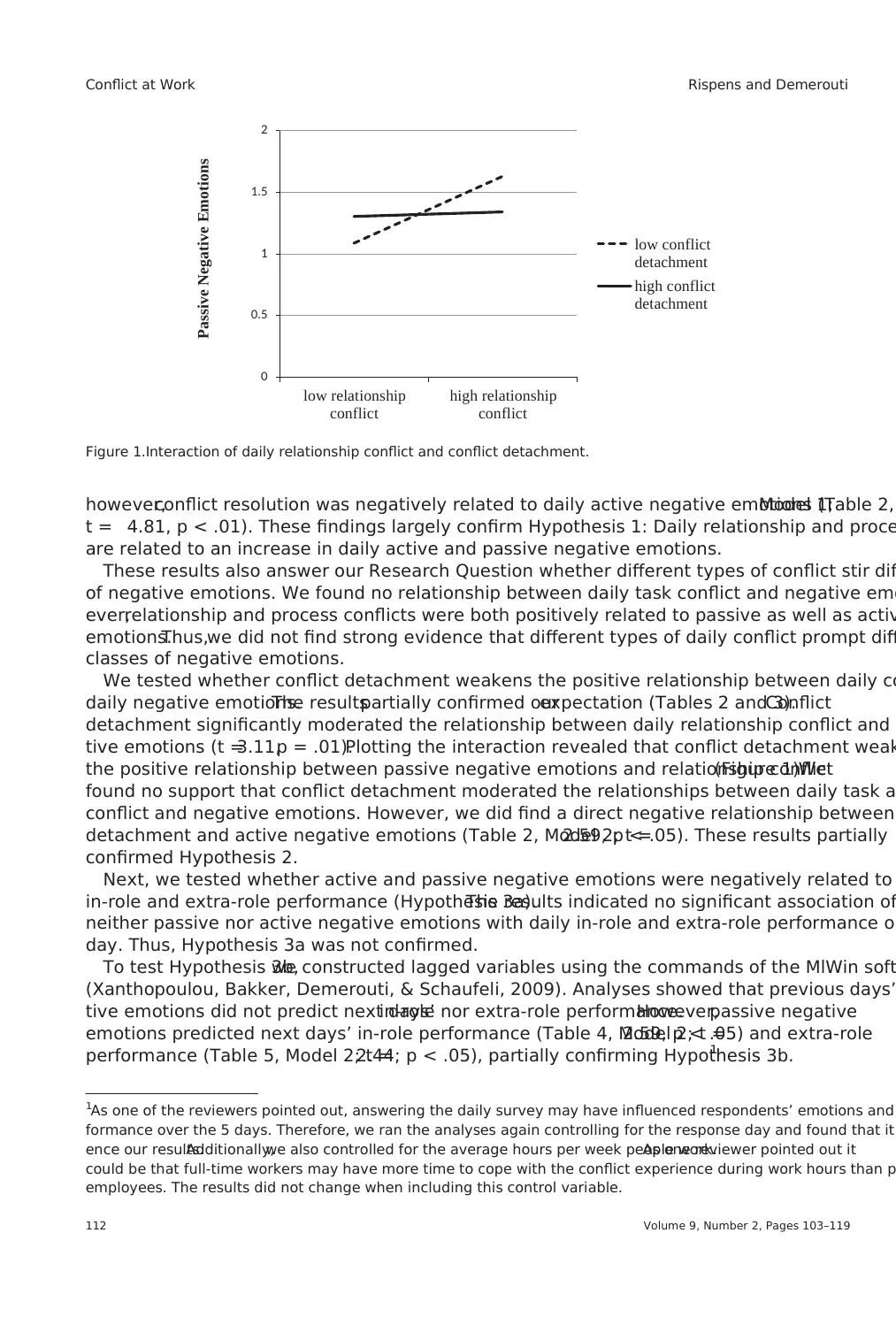
however,conflict resolution was negatively related to daily active negative emotions (Table 2,Model 1;
t = 4.81, p < .01). These findings largely confirm Hypothesis 1: Daily relationship and proce
are related to an increase in daily active and passive negative emotions.
These results also answer our Research Question whether different types of conflict stir diff
of negative emotions. We found no relationship between daily task conflict and negative emo
ever,relationship and process conflicts were both positively related to passive as well as activ
emotions.Thus,we did not find strong evidence that different types of daily conflict prompt diff
classes of negative emotions.
We tested whether conflict detachment weakens the positive relationship between daily co
daily negative emotions.The resultspartially confirmed ourexpectation (Tables 2 and 3).Conflict
detachment significantly moderated the relationship between daily relationship conflict and
tive emotions (t =3.11,p = .01).Plotting the interaction revealed that conflict detachment weak
the positive relationship between passive negative emotions and relationship conflict(Figure 1).We
found no support that conflict detachment moderated the relationships between daily task a
conflict and negative emotions. However, we did find a direct negative relationship between
detachment and active negative emotions (Table 2, Model 2; t =2.59, p < .05). These results partially
confirmed Hypothesis 2.
Next, we tested whether active and passive negative emotions were negatively related to
in-role and extra-role performance (Hypothesis 3a).The results indicated no significant association of
neither passive nor active negative emotions with daily in-role and extra-role performance on
day. Thus, Hypothesis 3a was not confirmed.
To test Hypothesis 3b,we constructed lagged variables using the commands of the MlWin soft
(Xanthopoulou, Bakker, Demerouti, & Schaufeli, 2009). Analyses showed that previous days’
tive emotions did not predict next days’in-role nor extra-role performance.However,passive negative
emotions predicted next days’ in-role performance (Table 4, Model 2; t =2.59, p < .05) and extra-role
performance (Table 5, Model 2; t =2.44; p < .05), partially confirming Hypothesis 3b.1
0
0.5
1
1.5
2
low relationship
conflict
high relationship
conflict
low conflict
detachment
high conflict
detachment
Passive Negative Emotions
Figure 1.Interaction of daily relationship conflict and conflict detachment.
1As one of the reviewers pointed out, answering the daily survey may have influenced respondents’ emotions and
formance over the 5 days. Therefore, we ran the analyses again controlling for the response day and found that it
ence our results.Additionally,we also controlled for the average hours per week people work.As one reviewer pointed out it
could be that full-time workers may have more time to cope with the conflict experience during work hours than p
employees. The results did not change when including this control variable.
Volume 9, Number 2, Pages 103–119112
Conflict at Work Rispens and Demerouti
t = 4.81, p < .01). These findings largely confirm Hypothesis 1: Daily relationship and proce
are related to an increase in daily active and passive negative emotions.
These results also answer our Research Question whether different types of conflict stir diff
of negative emotions. We found no relationship between daily task conflict and negative emo
ever,relationship and process conflicts were both positively related to passive as well as activ
emotions.Thus,we did not find strong evidence that different types of daily conflict prompt diff
classes of negative emotions.
We tested whether conflict detachment weakens the positive relationship between daily co
daily negative emotions.The resultspartially confirmed ourexpectation (Tables 2 and 3).Conflict
detachment significantly moderated the relationship between daily relationship conflict and
tive emotions (t =3.11,p = .01).Plotting the interaction revealed that conflict detachment weak
the positive relationship between passive negative emotions and relationship conflict(Figure 1).We
found no support that conflict detachment moderated the relationships between daily task a
conflict and negative emotions. However, we did find a direct negative relationship between
detachment and active negative emotions (Table 2, Model 2; t =2.59, p < .05). These results partially
confirmed Hypothesis 2.
Next, we tested whether active and passive negative emotions were negatively related to
in-role and extra-role performance (Hypothesis 3a).The results indicated no significant association of
neither passive nor active negative emotions with daily in-role and extra-role performance on
day. Thus, Hypothesis 3a was not confirmed.
To test Hypothesis 3b,we constructed lagged variables using the commands of the MlWin soft
(Xanthopoulou, Bakker, Demerouti, & Schaufeli, 2009). Analyses showed that previous days’
tive emotions did not predict next days’in-role nor extra-role performance.However,passive negative
emotions predicted next days’ in-role performance (Table 4, Model 2; t =2.59, p < .05) and extra-role
performance (Table 5, Model 2; t =2.44; p < .05), partially confirming Hypothesis 3b.1
0
0.5
1
1.5
2
low relationship
conflict
high relationship
conflict
low conflict
detachment
high conflict
detachment
Passive Negative Emotions
Figure 1.Interaction of daily relationship conflict and conflict detachment.
1As one of the reviewers pointed out, answering the daily survey may have influenced respondents’ emotions and
formance over the 5 days. Therefore, we ran the analyses again controlling for the response day and found that it
ence our results.Additionally,we also controlled for the average hours per week people work.As one reviewer pointed out it
could be that full-time workers may have more time to cope with the conflict experience during work hours than p
employees. The results did not change when including this control variable.
Volume 9, Number 2, Pages 103–119112
Conflict at Work Rispens and Demerouti
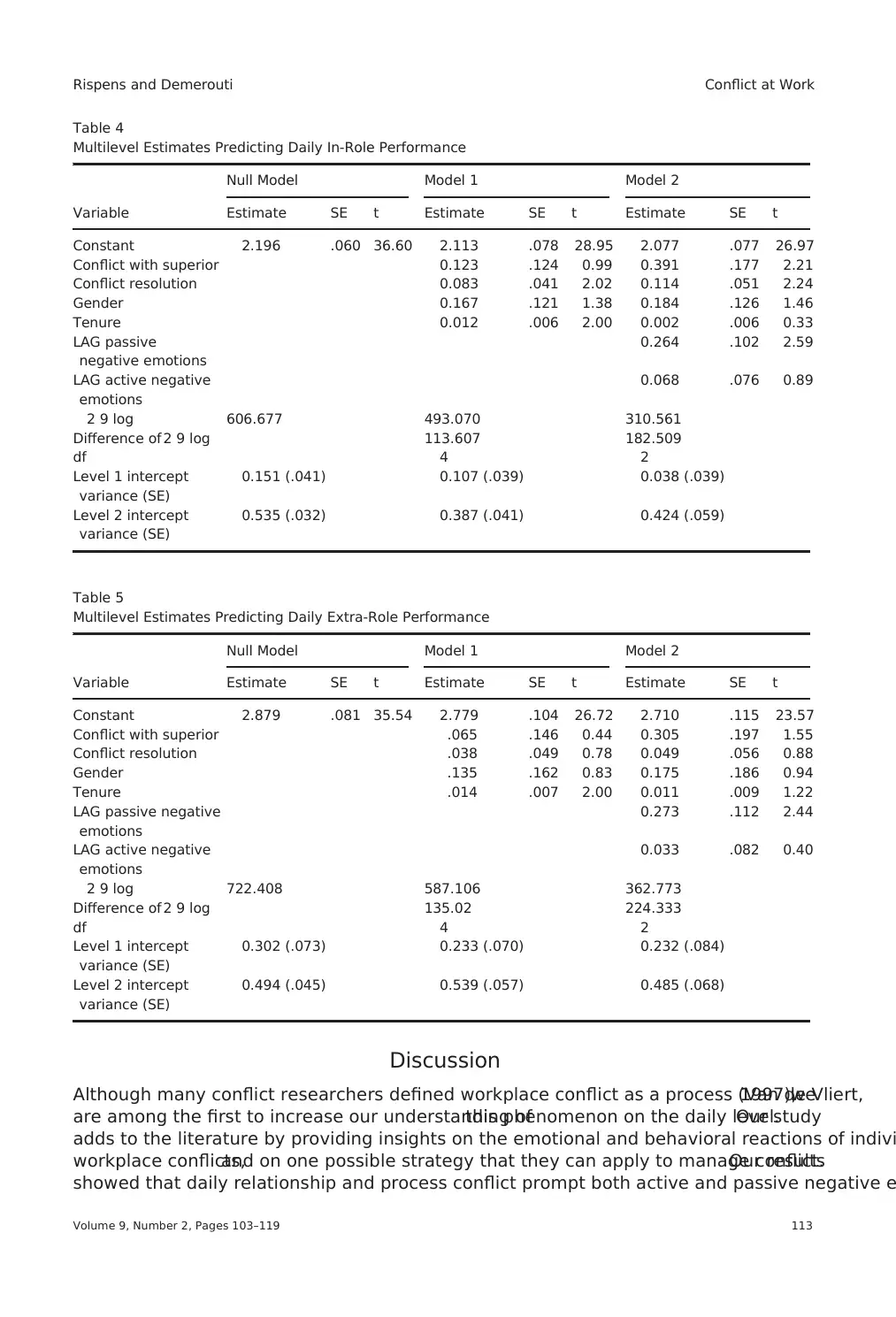
Discussion
Although many conflict researchers defined workplace conflict as a process (Van de Vliert,1997),we
are among the first to increase our understanding ofthis phenomenon on the daily level.Our study
adds to the literature by providing insights on the emotional and behavioral reactions of indivi
workplace conflicts,and on one possible strategy that they can apply to manage conflict.Our results
showed that daily relationship and process conflict prompt both active and passive negative e
Table 4
Multilevel Estimates Predicting Daily In-Role Performance
Variable
Null Model Model 1 Model 2
Estimate SE t Estimate SE t Estimate SE t
Constant 2.196 .060 36.60 2.113 .078 28.95 2.077 .077 26.97
Conflict with superior 0.123 .124 0.99 0.391 .177 2.21
Conflict resolution 0.083 .041 2.02 0.114 .051 2.24
Gender 0.167 .121 1.38 0.184 .126 1.46
Tenure 0.012 .006 2.00 0.002 .006 0.33
LAG passive
negative emotions
0.264 .102 2.59
LAG active negative
emotions
0.068 .076 0.89
2 9 log 606.677 493.070 310.561
Difference of 2 9 log 113.607 182.509
df 4 2
Level 1 intercept
variance (SE)
0.151 (.041) 0.107 (.039) 0.038 (.039)
Level 2 intercept
variance (SE)
0.535 (.032) 0.387 (.041) 0.424 (.059)
Table 5
Multilevel Estimates Predicting Daily Extra-Role Performance
Variable
Null Model Model 1 Model 2
Estimate SE t Estimate SE t Estimate SE t
Constant 2.879 .081 35.54 2.779 .104 26.72 2.710 .115 23.57
Conflict with superior .065 .146 0.44 0.305 .197 1.55
Conflict resolution .038 .049 0.78 0.049 .056 0.88
Gender .135 .162 0.83 0.175 .186 0.94
Tenure .014 .007 2.00 0.011 .009 1.22
LAG passive negative
emotions
0.273 .112 2.44
LAG active negative
emotions
0.033 .082 0.40
2 9 log 722.408 587.106 362.773
Difference of 2 9 log 135.02 224.333
df 4 2
Level 1 intercept
variance (SE)
0.302 (.073) 0.233 (.070) 0.232 (.084)
Level 2 intercept
variance (SE)
0.494 (.045) 0.539 (.057) 0.485 (.068)
Volume 9, Number 2, Pages 103–119 113
Rispens and Demerouti Conflict at Work
Although many conflict researchers defined workplace conflict as a process (Van de Vliert,1997),we
are among the first to increase our understanding ofthis phenomenon on the daily level.Our study
adds to the literature by providing insights on the emotional and behavioral reactions of indivi
workplace conflicts,and on one possible strategy that they can apply to manage conflict.Our results
showed that daily relationship and process conflict prompt both active and passive negative e
Table 4
Multilevel Estimates Predicting Daily In-Role Performance
Variable
Null Model Model 1 Model 2
Estimate SE t Estimate SE t Estimate SE t
Constant 2.196 .060 36.60 2.113 .078 28.95 2.077 .077 26.97
Conflict with superior 0.123 .124 0.99 0.391 .177 2.21
Conflict resolution 0.083 .041 2.02 0.114 .051 2.24
Gender 0.167 .121 1.38 0.184 .126 1.46
Tenure 0.012 .006 2.00 0.002 .006 0.33
LAG passive
negative emotions
0.264 .102 2.59
LAG active negative
emotions
0.068 .076 0.89
2 9 log 606.677 493.070 310.561
Difference of 2 9 log 113.607 182.509
df 4 2
Level 1 intercept
variance (SE)
0.151 (.041) 0.107 (.039) 0.038 (.039)
Level 2 intercept
variance (SE)
0.535 (.032) 0.387 (.041) 0.424 (.059)
Table 5
Multilevel Estimates Predicting Daily Extra-Role Performance
Variable
Null Model Model 1 Model 2
Estimate SE t Estimate SE t Estimate SE t
Constant 2.879 .081 35.54 2.779 .104 26.72 2.710 .115 23.57
Conflict with superior .065 .146 0.44 0.305 .197 1.55
Conflict resolution .038 .049 0.78 0.049 .056 0.88
Gender .135 .162 0.83 0.175 .186 0.94
Tenure .014 .007 2.00 0.011 .009 1.22
LAG passive negative
emotions
0.273 .112 2.44
LAG active negative
emotions
0.033 .082 0.40
2 9 log 722.408 587.106 362.773
Difference of 2 9 log 135.02 224.333
df 4 2
Level 1 intercept
variance (SE)
0.302 (.073) 0.233 (.070) 0.232 (.084)
Level 2 intercept
variance (SE)
0.494 (.045) 0.539 (.057) 0.485 (.068)
Volume 9, Number 2, Pages 103–119 113
Rispens and Demerouti Conflict at Work
⊘ This is a preview!⊘
Do you want full access?
Subscribe today to unlock all pages.

Trusted by 1+ million students worldwide
1 out of 18
Your All-in-One AI-Powered Toolkit for Academic Success.
+13062052269
info@desklib.com
Available 24*7 on WhatsApp / Email
![[object Object]](/_next/static/media/star-bottom.7253800d.svg)
Unlock your academic potential
Copyright © 2020–2025 A2Z Services. All Rights Reserved. Developed and managed by ZUCOL.